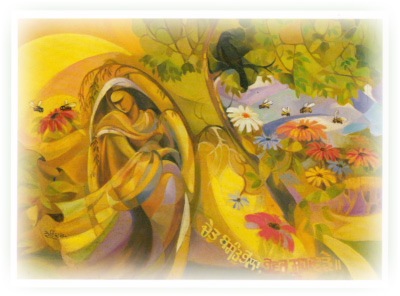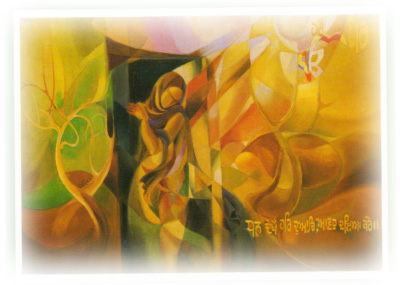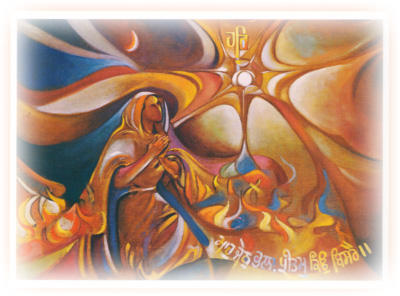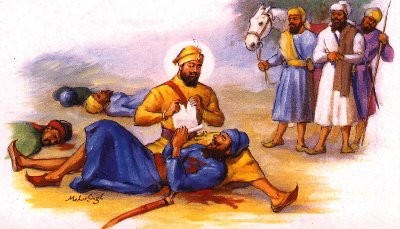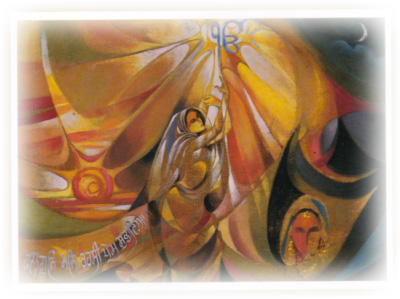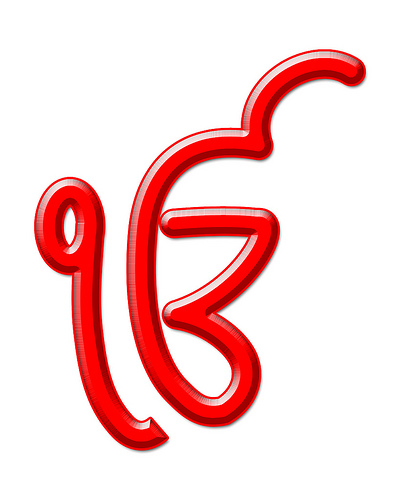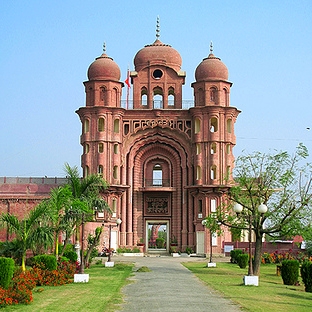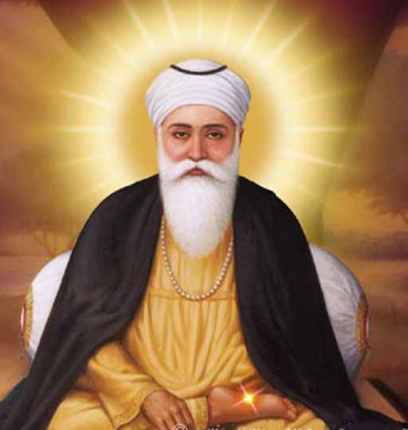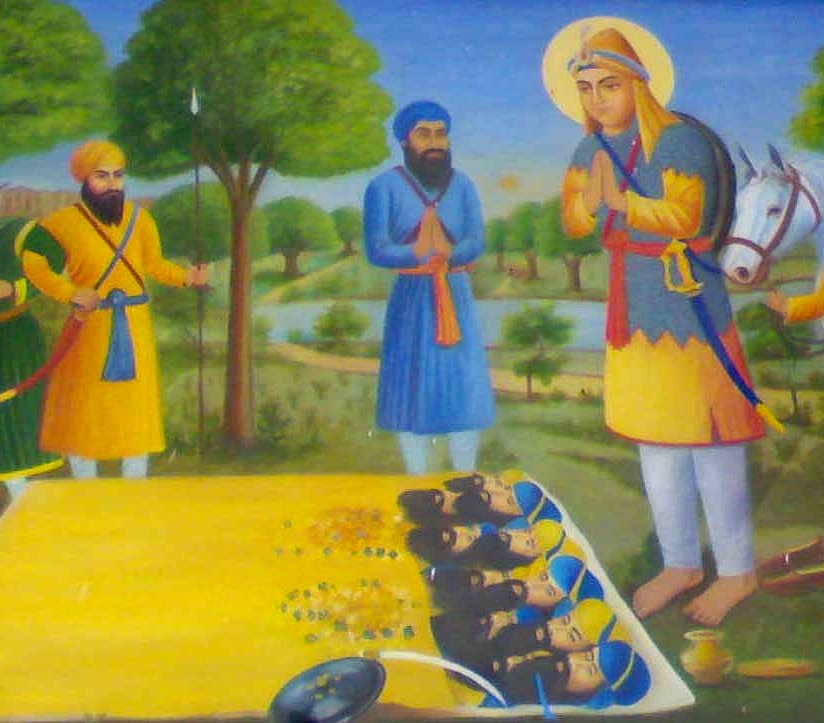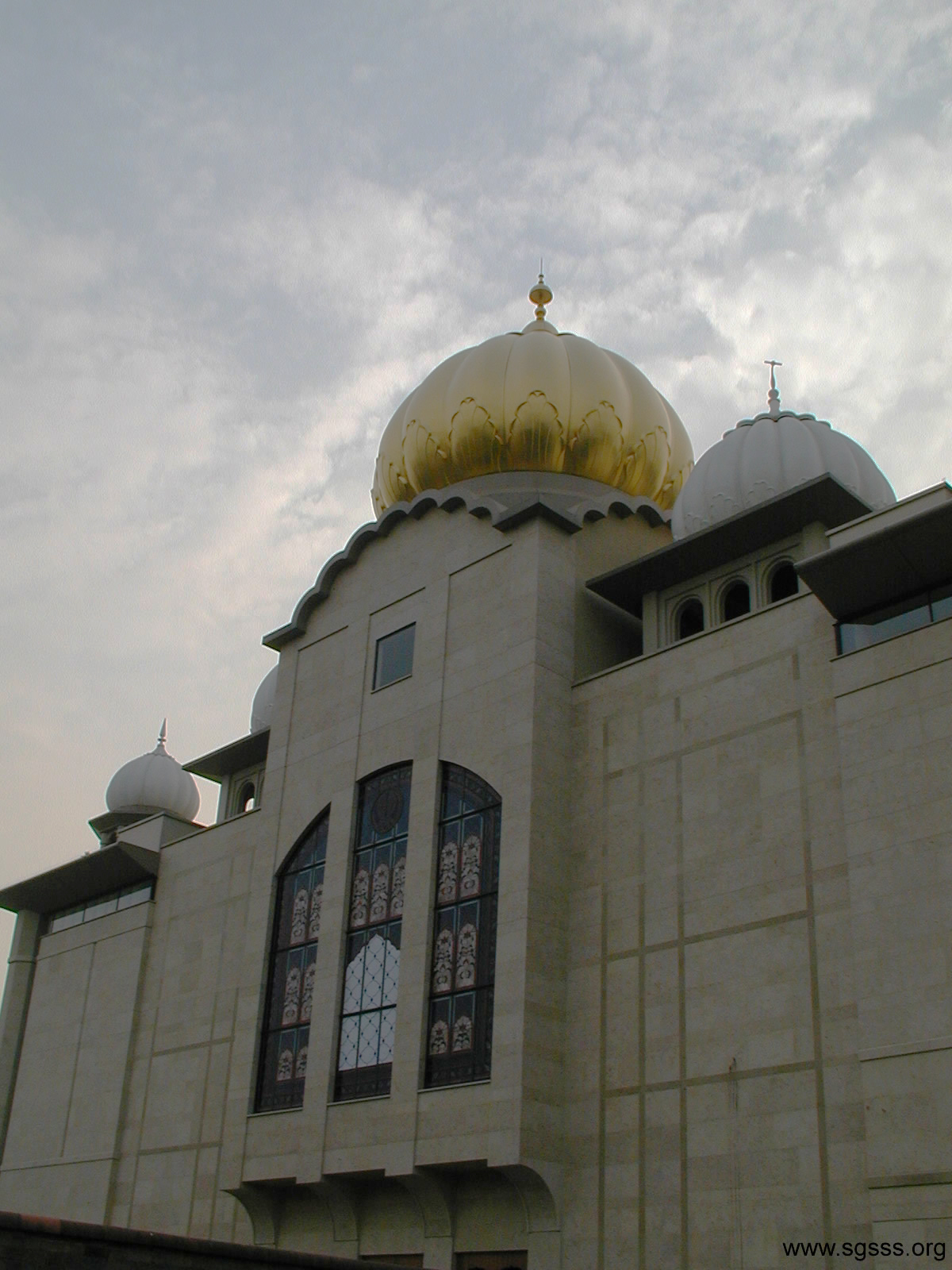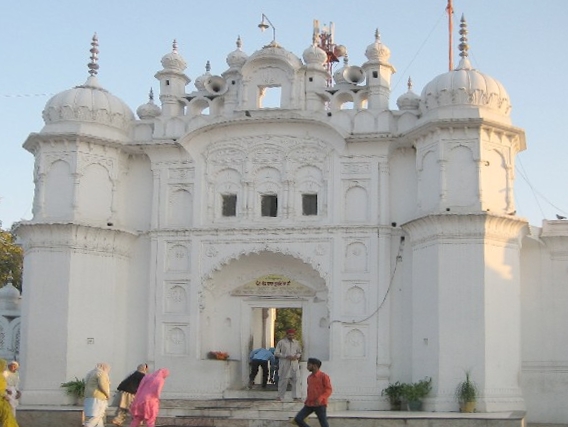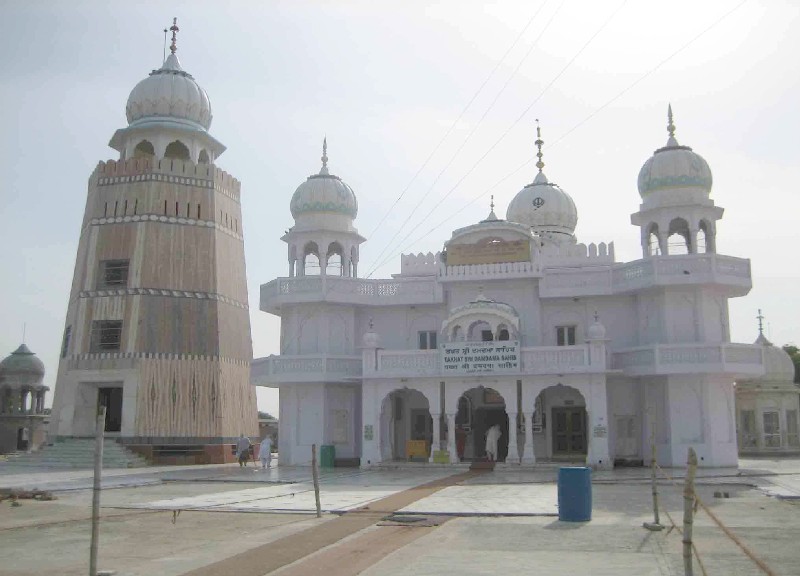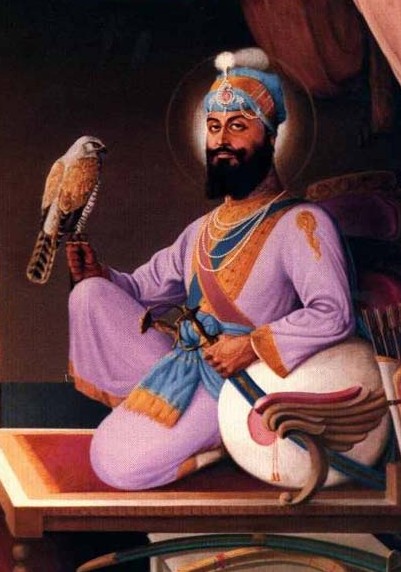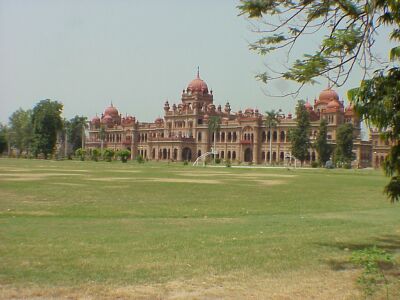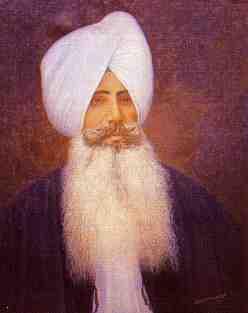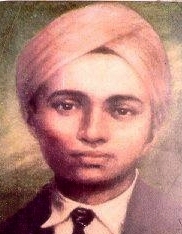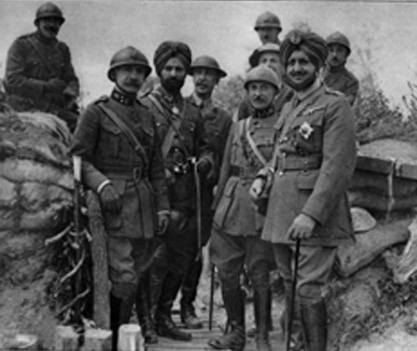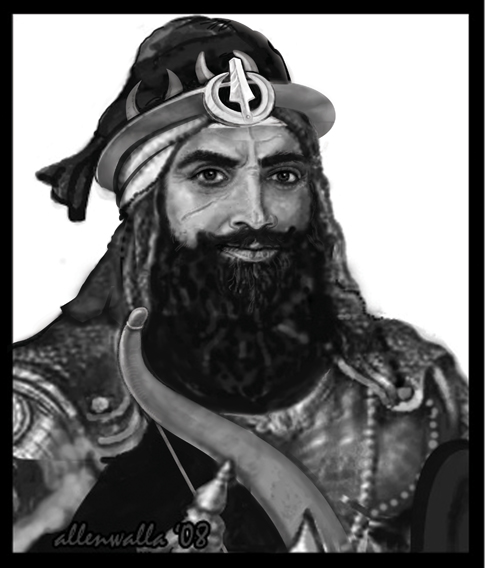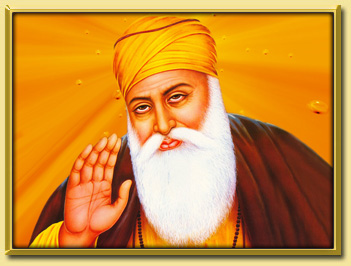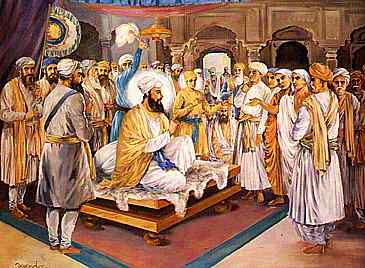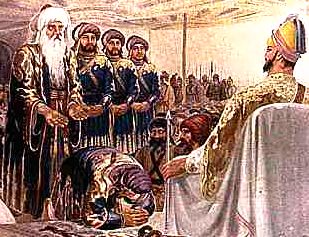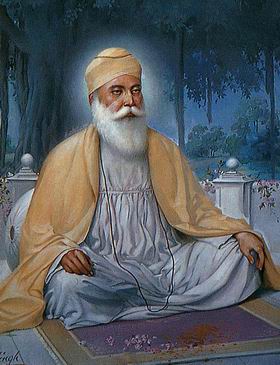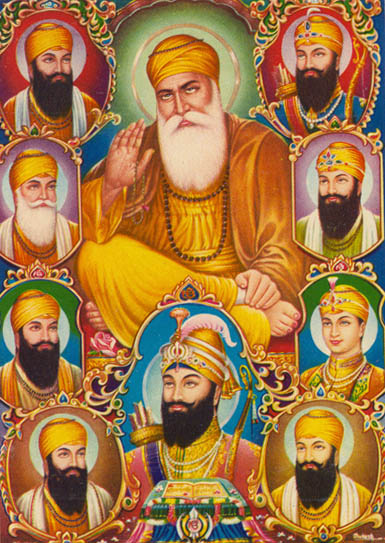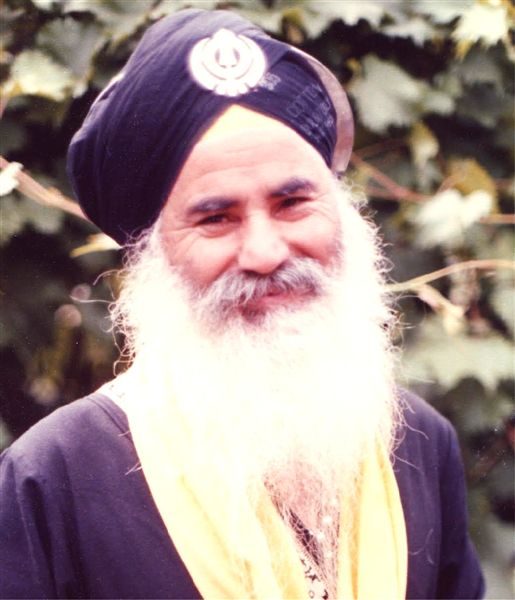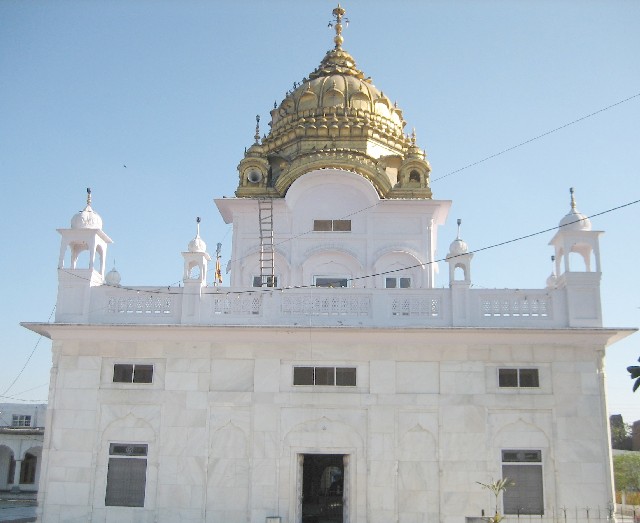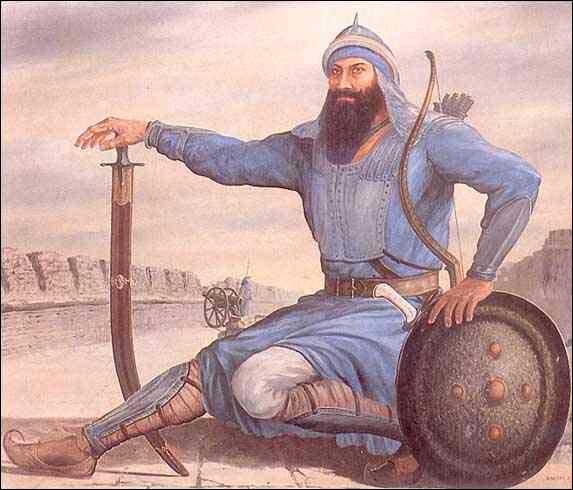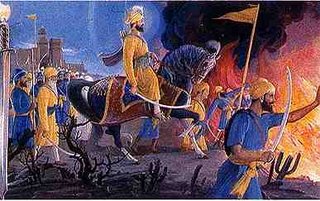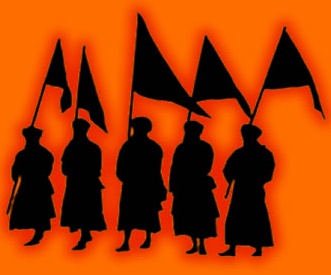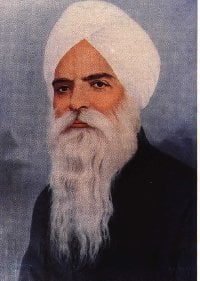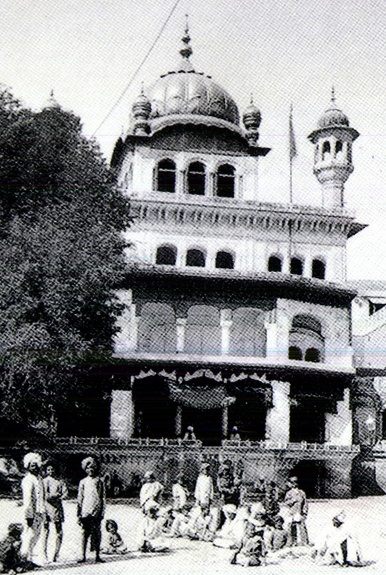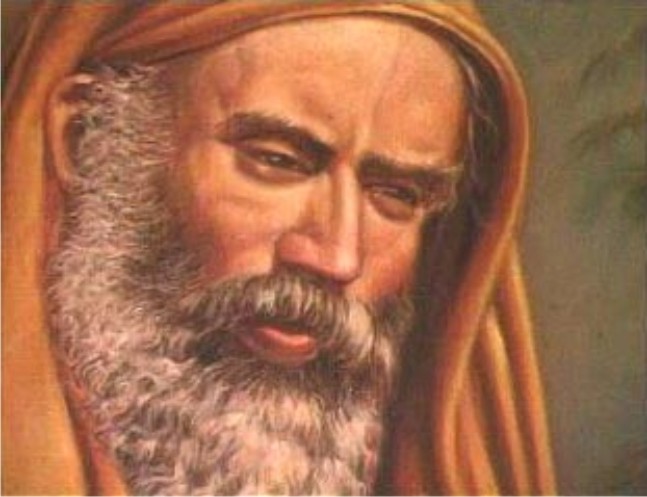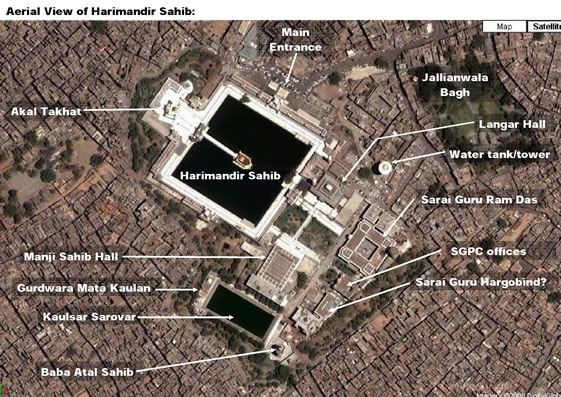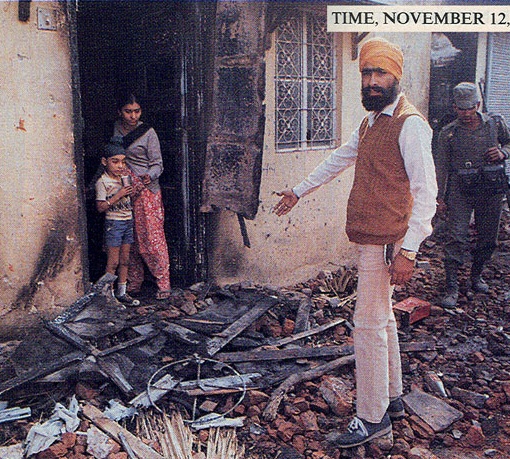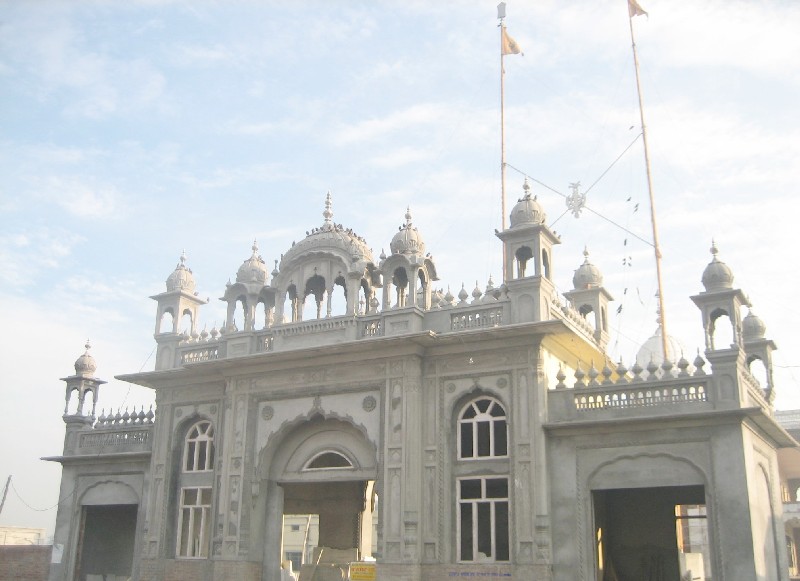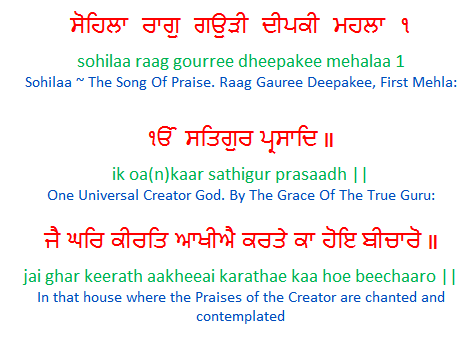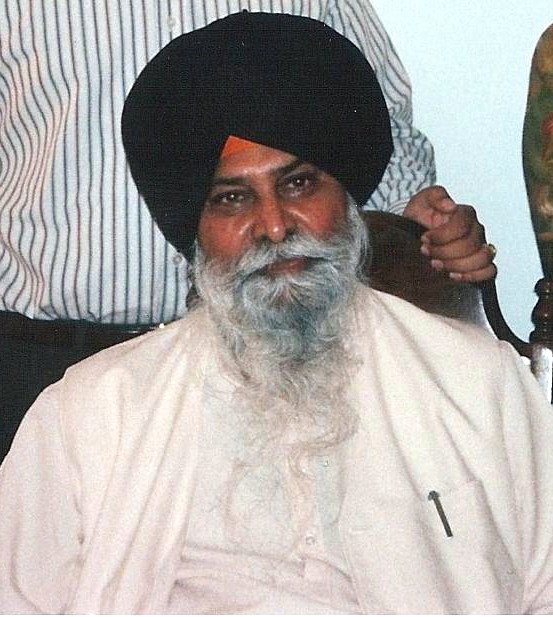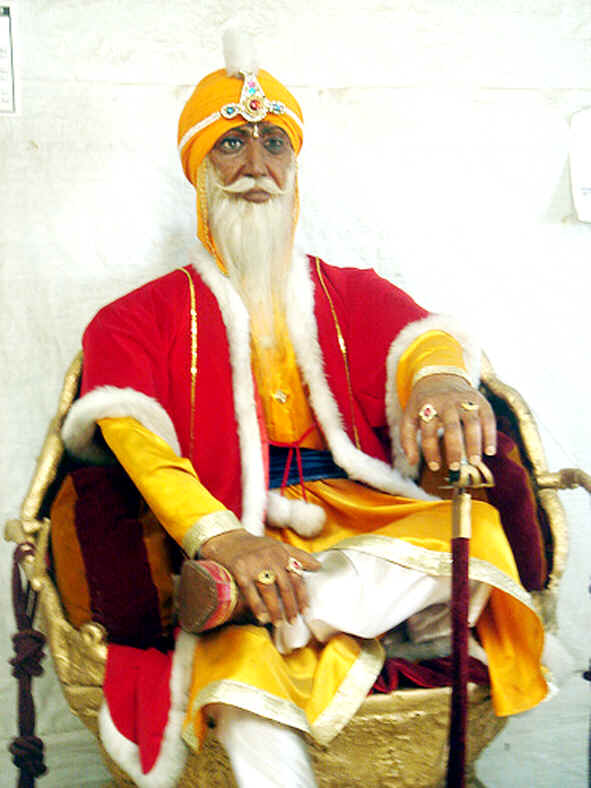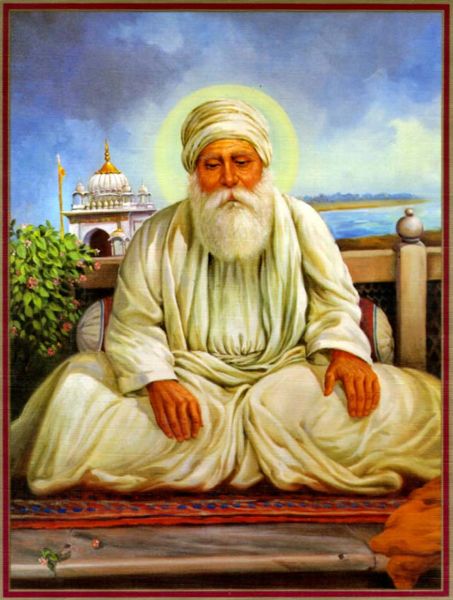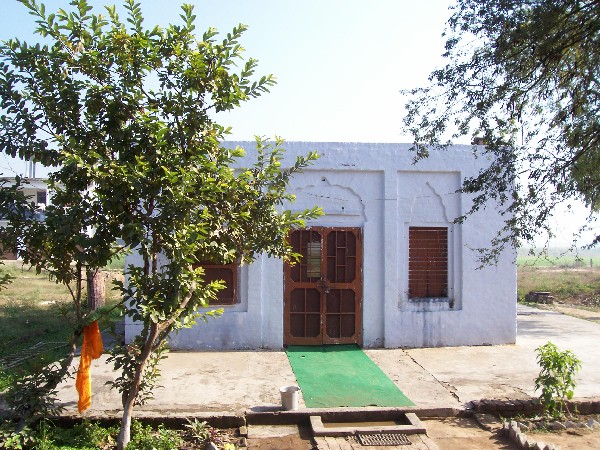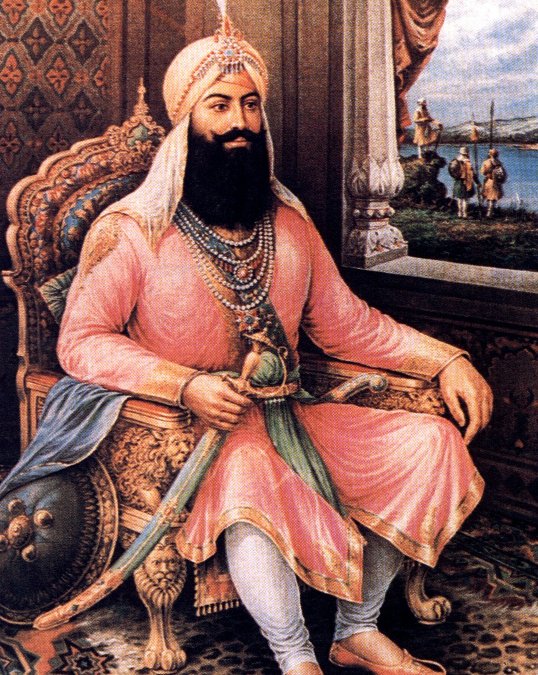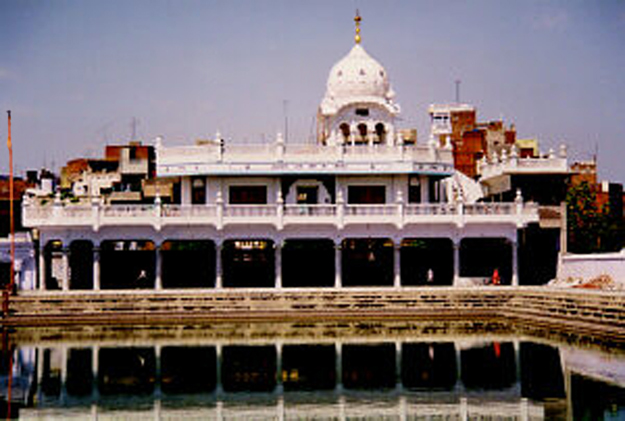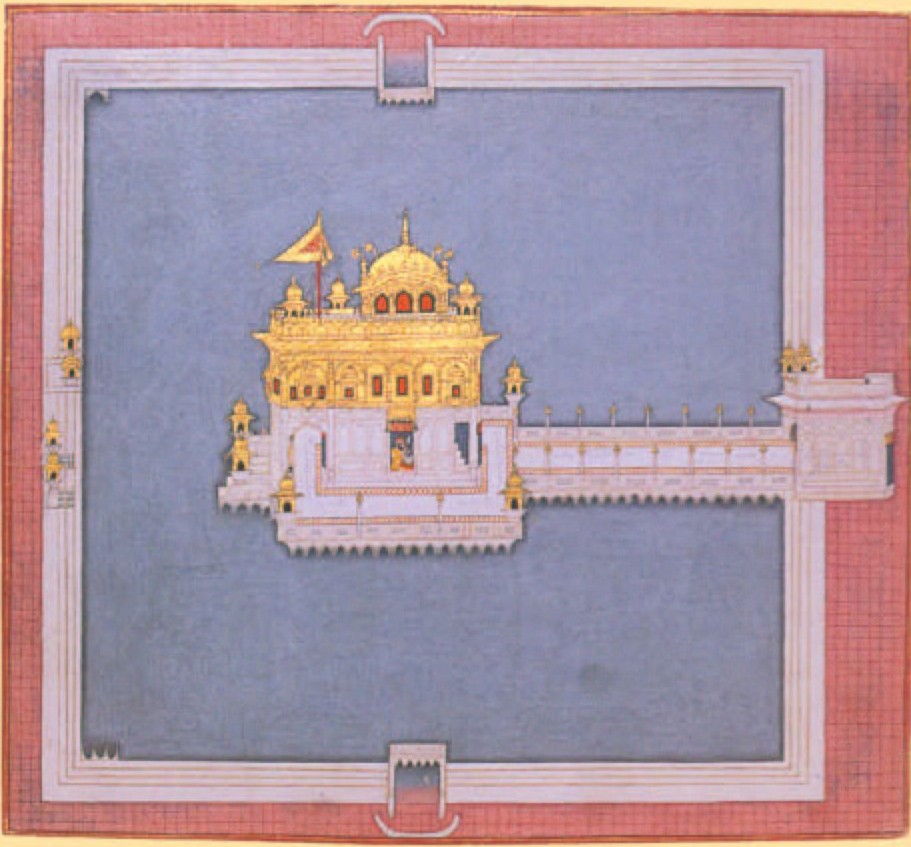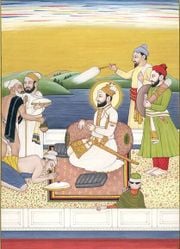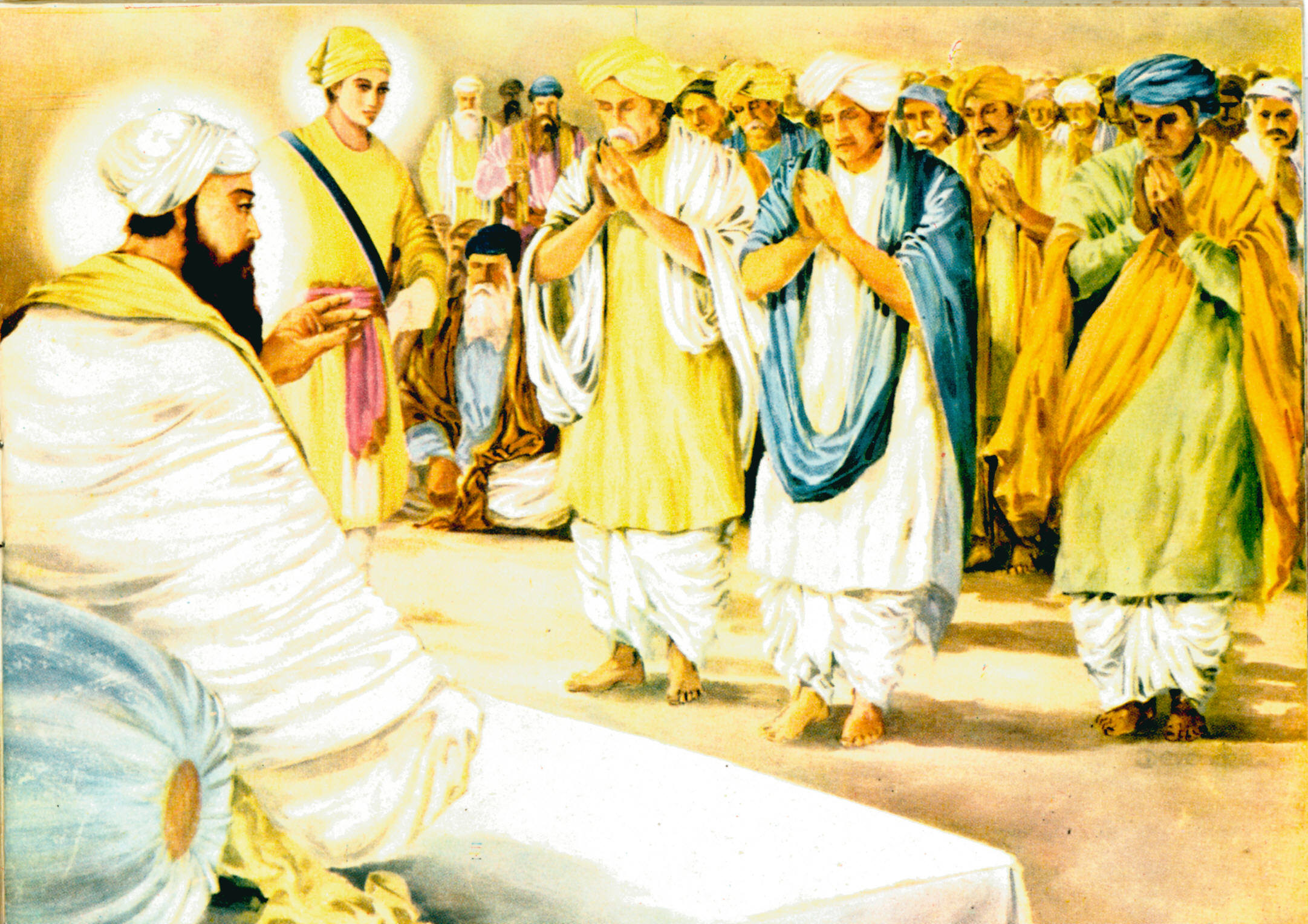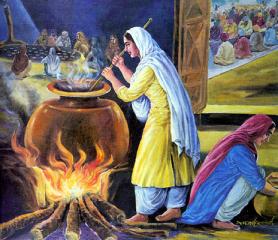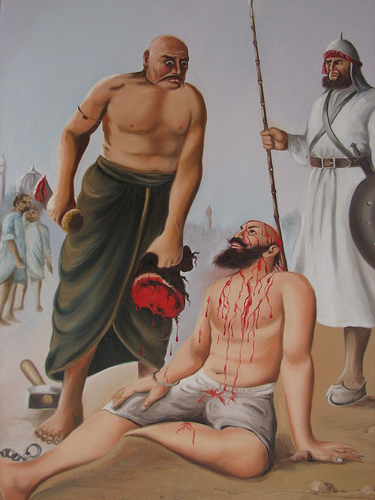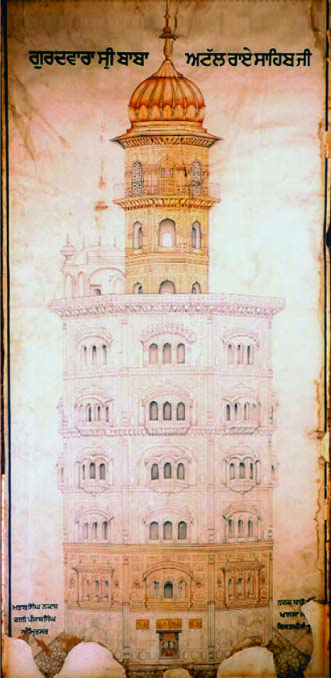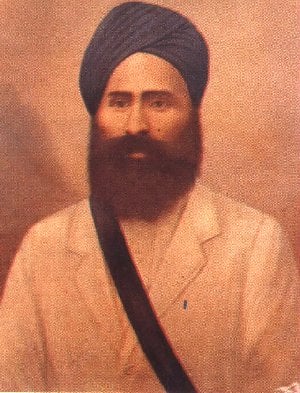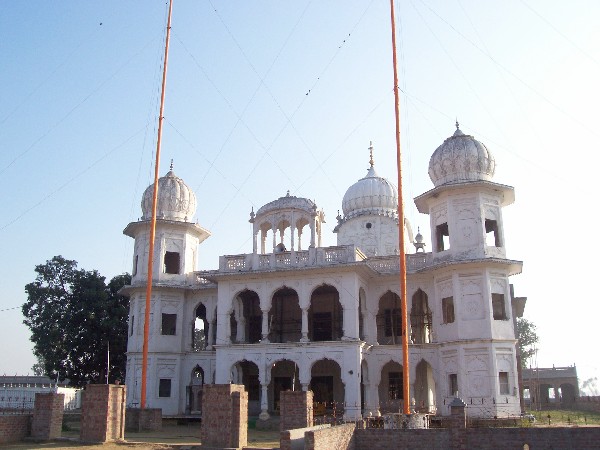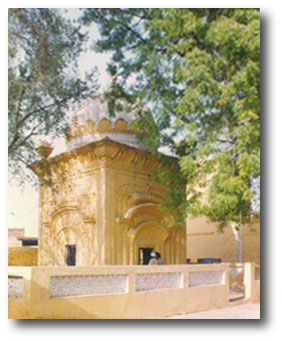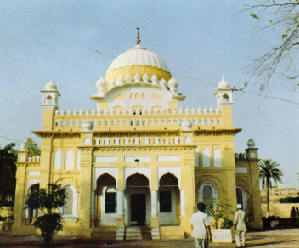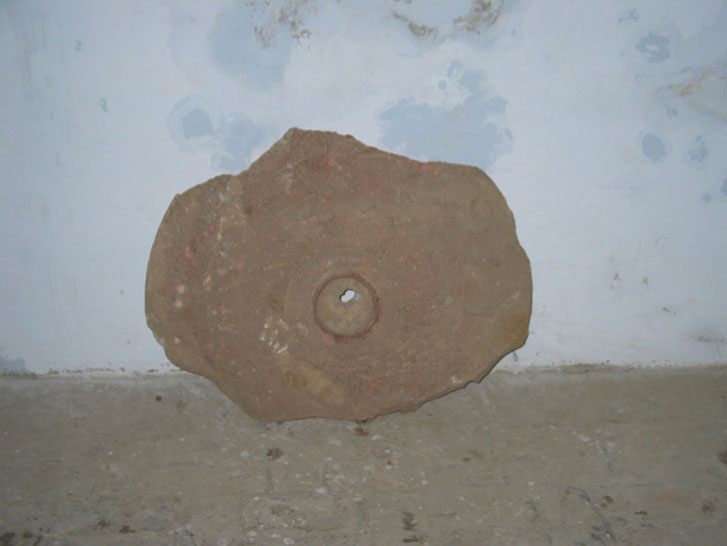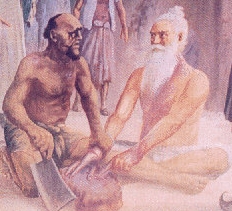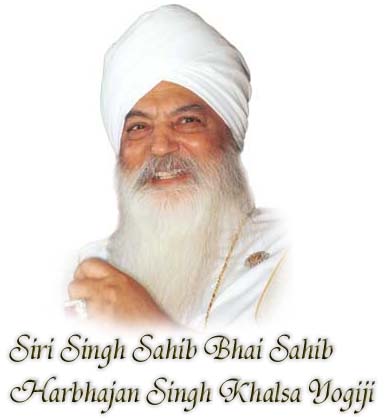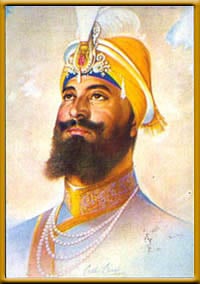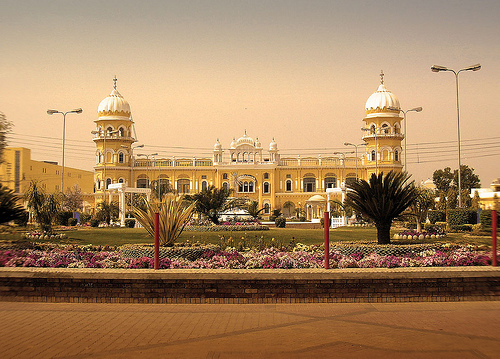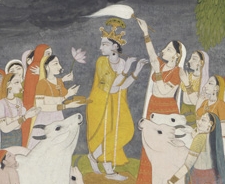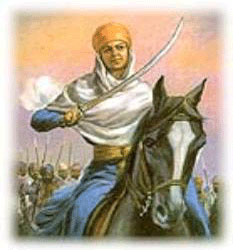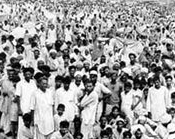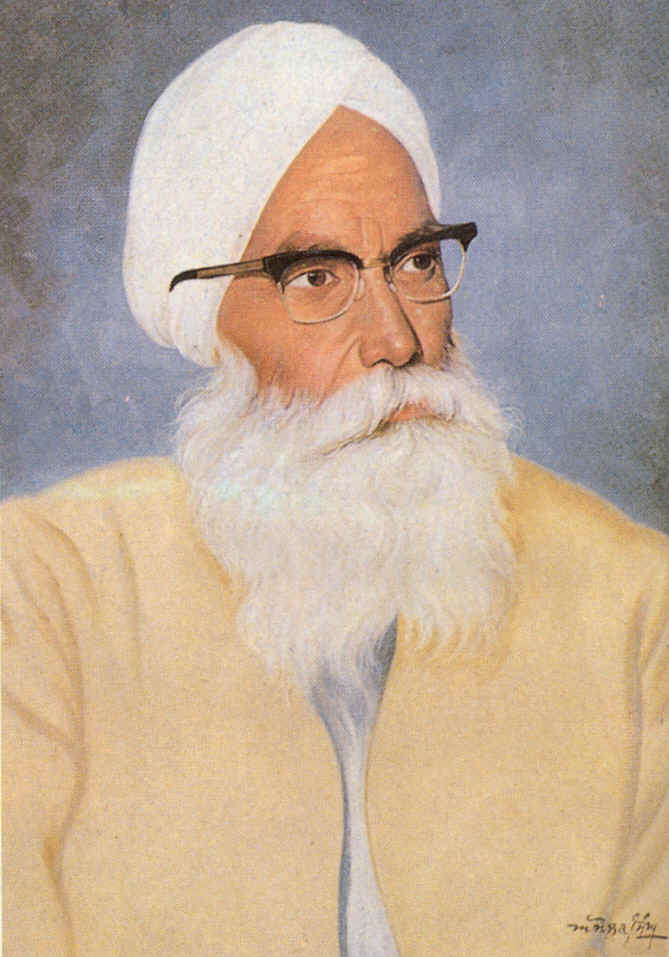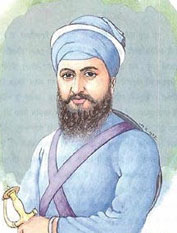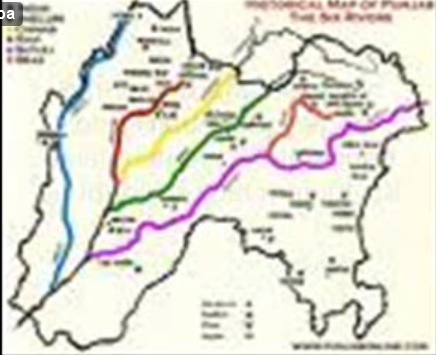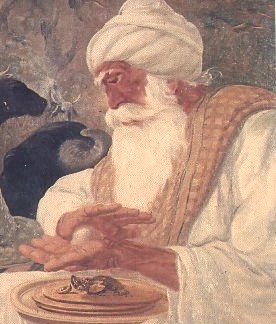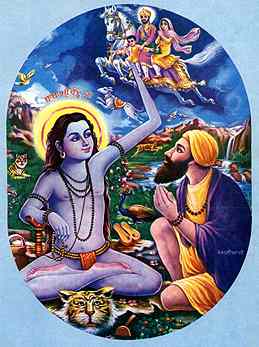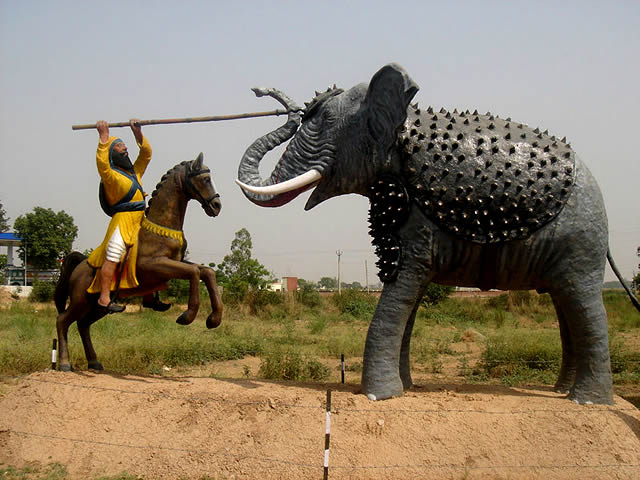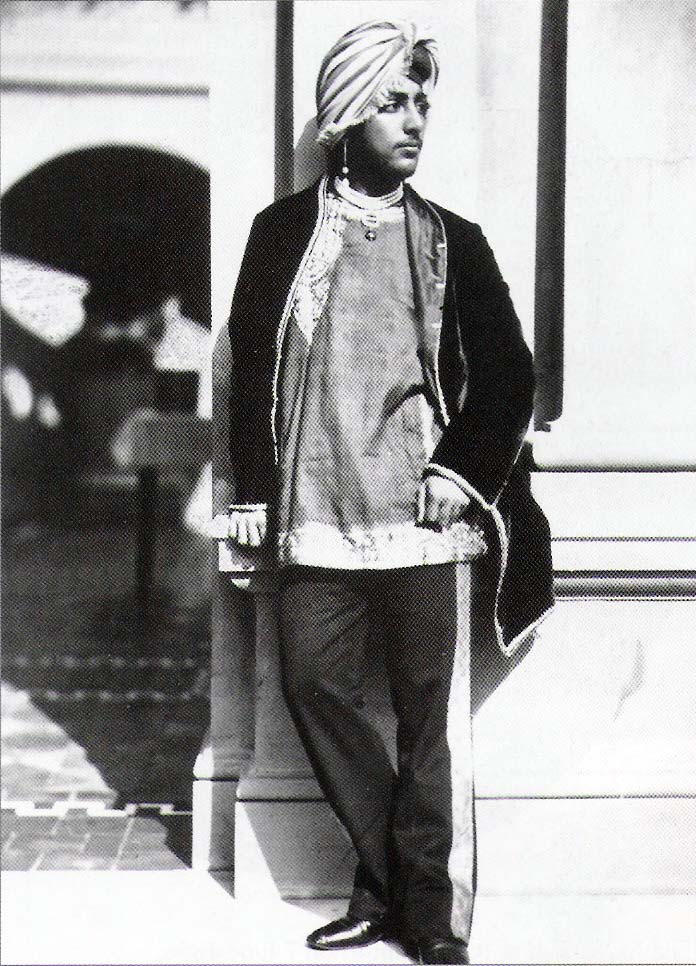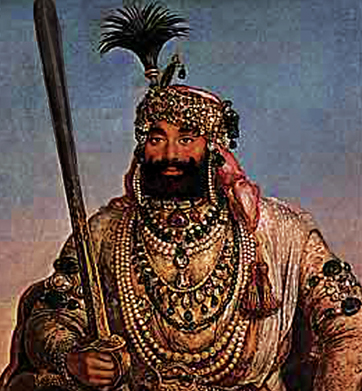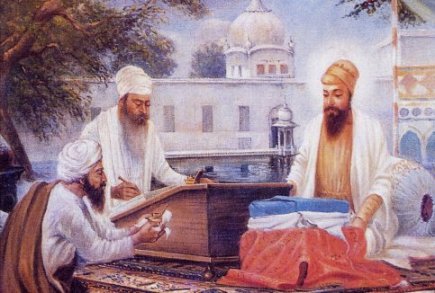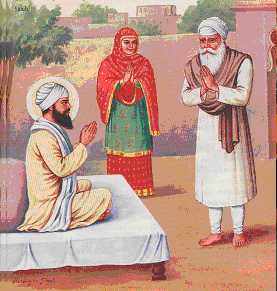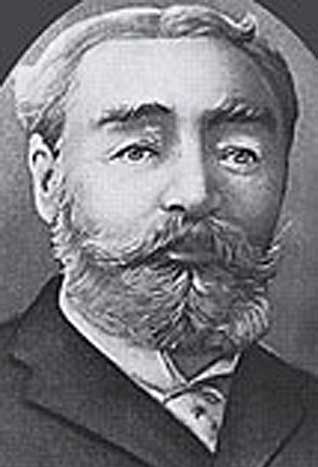AOW 200 to 299
Archived list of previously featured articles (AOW - Article of the Week) Original format - Full screen width.
- New Format - Half screen width - Archived Articles of the Week
- Proposed Featured Articles
- AOW 1 to 99
- AOW 100 to 199
- AOW 300 to 399
Contents: Top
200 201 202 203 204 205 206 207 208 209 210 211 212 213 214 215 216 217 218 219
220 221 222 223 224 225 226 227 228 229 230 231 232 233 234 235 236 237 238 239
240 241 242 243 244 245 246 247 248 249 250 251 252 253 254 255 256 257 258 259
260 261 262 263 264 265 266 267 268 269 270 271 272 273 274 275 276 277 278 279
280 281 282 283 284 285 286 287 288 289 290 291 292 293 294 295 296 297 298 299
- Select all the Pictures of the Week: ALL POW
- Select all the Guru's Messages: All Guru's Messages
- This is a list of all Article of the Weeks: AOW 200 to 299
201
Chet - Happy New Year
Chet is a first month in the Nanakshahi calendar, which governs the activities within Sikhism. The month starts on March 14 which also marks the beginning of the Nanakshahi New Year.
The month of Chet ends on April 13. This month coincides with March - April of the Western/Georgian/Julian Calendar and is 31 days long. Also on March 14 every year, the Sikhs celebrate the Gur gadi (Guruship) of their seventh master, Guru Har Rai.
On April 14 starts the second month of the Sikh calendar called Vaisakh. During Chet the season in Punjab, the land of the Sikh Gurus is spring and the climate is moderate with good sunshine during the day. The winter cold has truly been completely uplifted. Many tourists from western countries visit north India during Chet to join in the festivities of the New year and Holla Mahalla.
The Guru tells us that in the month of Chet (March/April): ".... by meditating on the Lord of the Universe, a deep and profound joy arises. Meeting with the humble Saints, the Lord is found, as we chant His Name with our tongues. Those who have found God-blessed is their coming into this world. Those who live without Him, for even an instant-their lives are rendered useless. The Lord is totally pervading the water, the land, and all space. He is contained in the forests as well. Those who do not remember God-how much pain must they suffer! Those who dwell upon their God have great good fortune. My mind yearns for the Blessed Vision of the Lord's Darshan. O Nanak, my mind is so thirsty! I touch the feet of one who unites me with God in the month of Chayt.||2||" (SGGS page 133) .....More
Contents: Top 200. 210. 220. 230. 240. 250. 260. 270. 280. 290.
202
Vaisakh
Vaisakh is a second month in the Nanakshahi calendar. This month coincides with April/May of the Western/Georgian/Julian Calendar and is when the crop is harvested in Punjab. This month begins on April 14 and end on May 15. On May 15 begins the third month of the Sikh calendar called Jeth. Vaisakhi is the most important festival in the Sikh calendar and it takes place on the first of the lunar month of Vaisakh, which falls this year on April 14. On this day the Khalsa was created and much celebration takes place worldwide in the form of Samagams, Nagar Kirtan, Gatka Exhibition, Akand Paaths, etc.
The Guru tells us that in the month of Vaisakh (April/May): ".... how can the bride be patient? She is separated from her Beloved. She has forgotten the Lord, her Life-companion, her Master; she has become attached to Maya, the deceitful one. Neither son, nor spouse, nor wealth shall go along with you-only the Eternal Lord. Entangled and enmeshed in the love of false occupations, the whole world is perishing. Without the Naam, the Name of the One Lord, they lose their lives in the hereafter. Forgetting the Merciful Lord, they are ruined. Without God, there is no other at all. Pure is the reputation of those who are attached to the Feet of the Beloved Lord. Nanak makes this prayer to God: ""Please, come and unite me with Yourself."" The month of Vaisaakh is beautiful and pleasant, when the Saint causes me to meet the Lord. ||3||" (SGGS page 133/4) .....More
Contents: Top 200. 210. 220. 230. 240. 250. 260. 270. 280. 290.
203
Jeth/Jayth is a third month in the Sikh Calendar, the Nanakshahi calendar. This month coincides with May/June of the Western/Georgian/Julian Calendar and is the month after the harvest festival in Punjab. This year the first day of this month falls on the 15 May. The month is 31 days long; it starts on May 15 and ends on June 14.
Next month on June 15, begins the fourth month in the Sikh Calendar called Harh. During this month, in Punjab, the land of the Sikh Gurus, the season is the beginning of summer and the climate is beginning to get hot. Most tourist wills want to begin to leave this area towards the end of the month as it starts becoming quite hot.
The Guru tells us that in the month of Jeth (May/June): ".... the bride longs to meet with the Lord. All bow in humility before Him. One who has grasped the hem of the robe of the Lord, the True Friend - no one can keep him in bondage. God's Name is the Jewel, the Pearl. It cannot be stolen or taken away. In the Lord are all pleasures which please the mind. As the Lord wishes, so He acts, and so His creatures act. They alone are called blessed, whom God has made His Own. If people could meet the Lord by their own efforts, why would they be crying out in the pain of separation? Meeting Him in the Saadh Sangat, the Company of the Holy, O Nanak, celestial bliss is enjoyed. In the month of Jayt'h, the playful Husband Lord meets her, upon whose forehead such good destiny is recorded. ||4||" (SGGS page 134) .....More
Contents: Top 200. 210. 220. 230. 240. 250. 260. 270. 280. 290.
204

(photo:Prabhu Singh)
Harh (the Guru calls this month "Aasaarh" (Gurmukhi: ਆਸਾੜੁ)) is the fourth month in the Nanakshahi calendar. This month coincides with June/July of the Western/Georgian/Julian Calendar and is 31 days in length.
The month begin on June 15 and ends on July 15. On July 16, begins the fifth month in the Sikh Calendar called Sawan.
During this month of Harh, in Punjab, the land of the Sikh Gurus the season is summer and the climate is hot to very hot. Most westerners will have left the area as the temperatures are in the high 30 degrees centigrade.
The Guru tells us that the month of Harh (June/July): ".... seems burning hot, to those who are not close to their Husband Lord. They have forsaken God the Primal Being, the Life of the World, and they have come to rely upon mere mortals. In the love of duality, the soul-bride is ruined; around her neck she wears the noose of Death. As you plant, so shall you harvest; your destiny is recorded on your forehead. The life-night passes away, and in the end, one comes to regret and repent, and then depart with no hope at all. Those who meet with the Holy Saints are liberated in the Court of the Lord. Show Your Mercy to me, O God; I am thirsty for the Blessed Vision of Your Darshan. Without You, God, there is no other at all. This is Nanak's humble prayer. The month of Aasaarh is pleasant, when the Feet of the Lord abide in the mind. ||5||" (SGGS page 134) .....More
Contents: Top 200. 210. 220. 230. 240. 250. 260. 270. 280. 290.
205

(photo:Prabhu Singh)
Sawan (pronounced "Saa-vn") is a fifth month in the Nanakshahi calendar, which govern the activities within Sikhism. This month coincides with July/August of the Western/Georgian/Julian Calendar and is 31 days long.
The month starts on July 16 and ends on August 15. On August 16 starts the sixth month in the Sikh calendar called Bhadon. The season in Punjab, the land of the Sikh Gurus is mid-summer and the climate is very hot. Temperatures can go as high as 40 degrees centigrade. Most tourists and local move into higher and more northern states to lower temperatures.
The Guru tells us that in the month of Sawan (July/August): "... the soul-bride is happy, if she falls in love with the Lotus Feet of the Lord. Her mind and body are imbued with the Love of the True One; His Name is her only Support. The pleasures of corruption are false. All that is seen shall turn to ashes. The drops of the Lord's Nectar are so beautiful! Meeting the Holy Saint, we drink these in. The forests and the meadows are rejuvenated and refreshed with the Love of God, the All-powerful, Infinite Primal Being. My mind yearns to meet the Lord. If only He would show His Mercy, and unite me with Himself! Those brides who have obtained God-I am forever a sacrifice to them. O Nanak, when the Dear Lord shows kindness, He adorns His bride with the Word of His Shabad. Saawan is delightful for those happy soul-brides whose hearts are adorned with the Necklace of the Lord's Name. ॥6॥" (SGGS page 134) .....More
Contents: Top 200. 210. 220. 230. 240. 250. 260. 270. 280. 290.
206
Bhadon
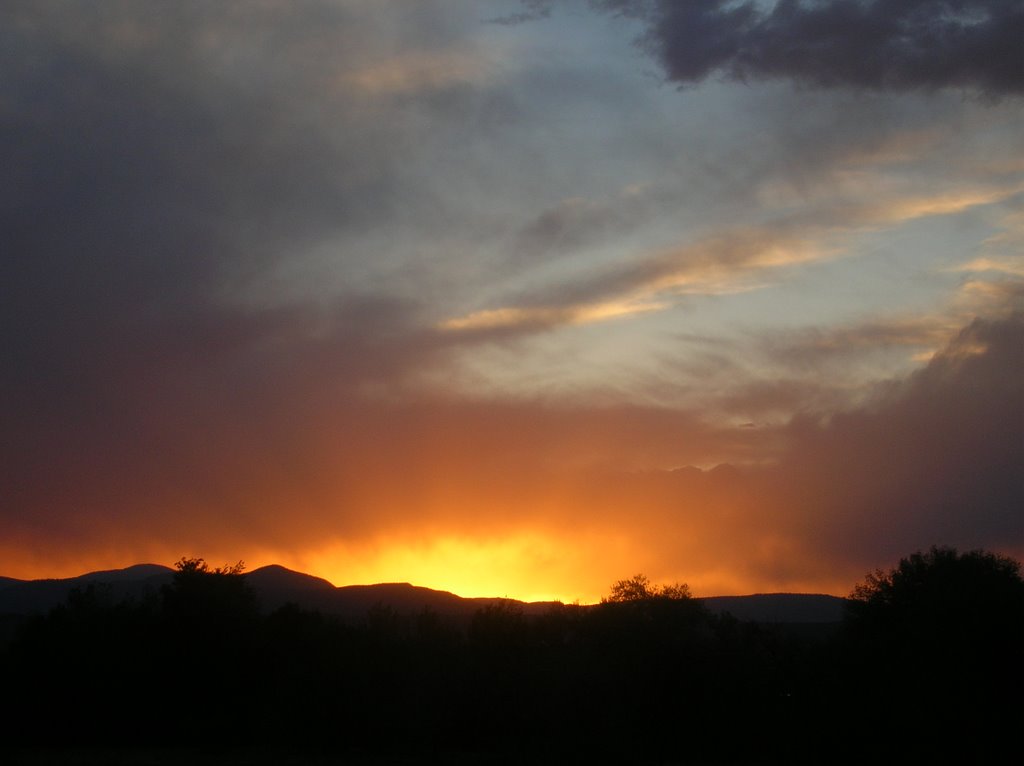
(photo:Prabhu Singh)
Bhadon is a sixth month in the Nanakshahi calendar. The first day falls on August 16. This month coincides with August/September of the Western/ Georgian/ Julian Calendar and is 31 days long.
Sawan and Bhadon form the rainy season. Rain has come after the very hot month of Harh which is considered the hottest month of the year. So Bhadon is considered a very pleasant month with rain and bearable heat in the Punjab, India.
The Guru tells us that the the month of Sawan (July/August) and Bhadon (August/September):
"The rainy season is beautiful; the months of Saawan and Bhaadon bring bliss. The clouds are low, and heavy with rain; the waters and the lands are filled with honey. God is all-pervading everywhere; the nine treasures of the Lord's Name fill the homes of all hearts...." (p 928) and also "...The lakes and fields are overflowing with water; the rainy season has come - the time to celebrate! In the dark of night it rains; how can the young bride find peace? The frogs and peacocks send out their noisy calls. Pri-o! Pri-o! Beloved! Beloved! cries the rainbird, while the snakes slither around, biting. The mosquitoes bite and sting, and the ponds are filled to overflowing; without the Lord, how can she find peace? O Nanak, I will go and ask my Guru; wherever God is, there I will go. ||10|| " (p1108) .....More
Contents: Top 200. 210. 220. 230. 240. 250. 260. 270. 280. 290.
207
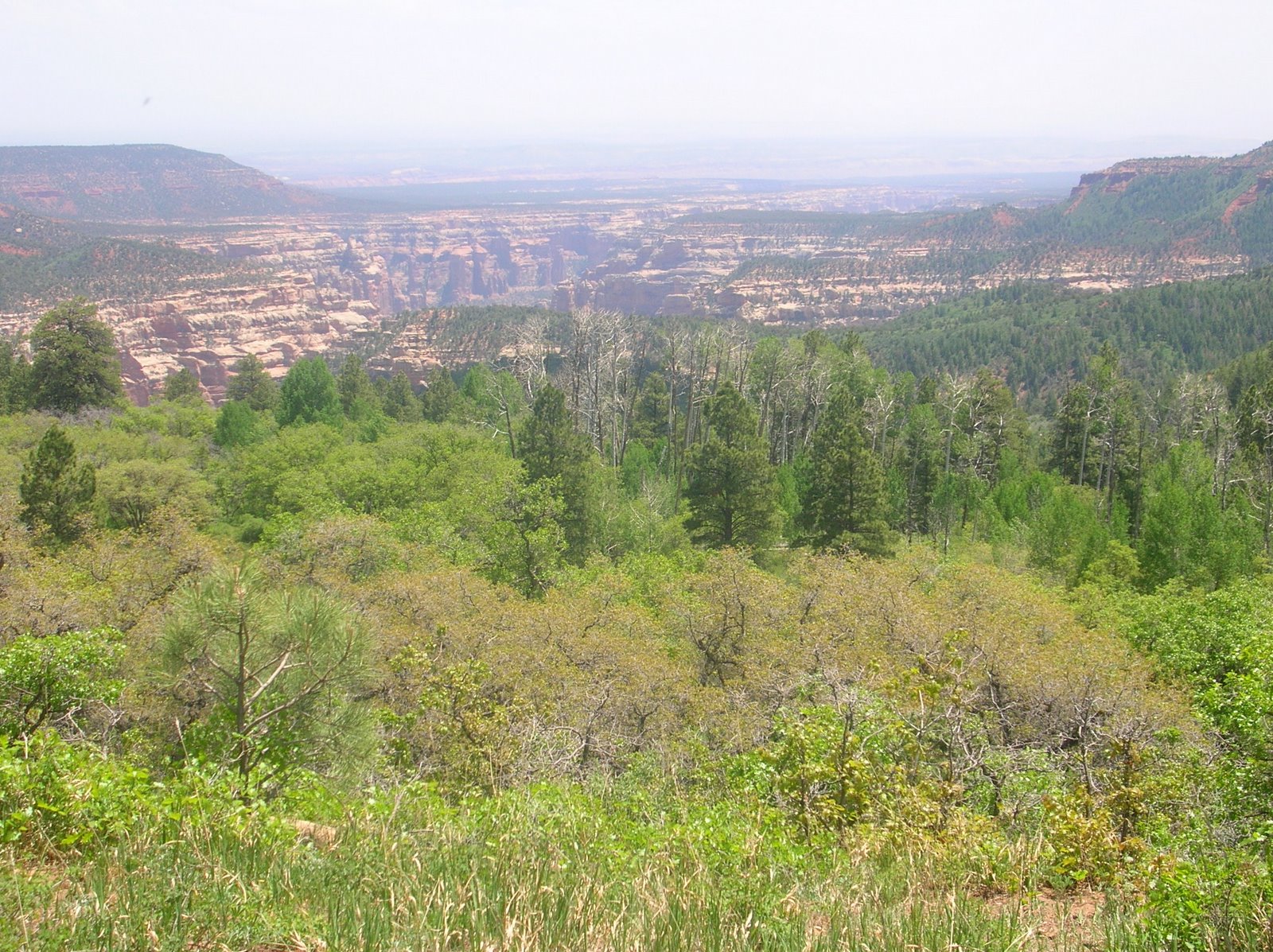
Assu is the seventh month in the Nanakshahi calendar, which governs the Sikh tradition. The first day of the month falls on September 15.
The month of Assu coincides with September/October of the Western/Georgian/Julian Calendar and is 30 days long.
While the preceding months of Sawan (July/August) and Bhadon (August/September) are hot and rainy in Punjab, in the month of Assu both the temperature and rain subside and the season is very pleasant.
The Guru tells us that in the month of Assu (September/October): "... my love for the Lord overwhelms me. How can I go and meet the Lord?
My mind and body are so thirsty for the Blessed Vision of His Darshan. Won't someone please come and lead me to him, O my mother. The Saints are the helpers of the Lord's lovers; I fall and touch their feet. Without God, how can I find peace? There is nowhere else to go. Those who have tasted the sublime essence of His Love, remain satisfied and fulfilled.
They renounce their selfishness and conceit, and they pray, "God, please attach me to the hem of Your robe". Those whom the Husband Lord has united with Himself, shall not be separated from Him again. Without God, there is no other at all. Nanak has entered the Sanctuary of the Lord. In Assu, the Lord, the Sovereign King, has granted His Mercy, and they dwell in peace. ((8)) " (SGGS page 134-5) .....More
Contents: Top 200. 210. 220. 230. 240. 250. 260. 270. 280. 290.
208

(photo:Prabhu Singh)
Katak is the eighth month in the Nanakshahi calendar; a calendar system which governs the Sikh tradition and is based from the birth of the founder of Sikhism, Guru Nanak in 1469. For the month of Katik (October/November), the Guru tells us:
"...In the month of Katak, do good deeds. Do not try to blame anyone else.
Forgetting the Transcendent Lord, all sorts of illnesses are contracted. Those who turn their backs on the Lord shall be separated from Him and consigned to reincarnation, over and over again.
In an instant, all of Maya's sensual pleasures turn bitter. No one can then serve as your intermediary.
Unto whom can we turn and cry?
Just by one's own actions, nothing can be done; destiny was pre-determined from the very beginning. .....More
Contents: Top 200. 210. 220. 230. 240. 250. 260. 270. 280. 290.
209
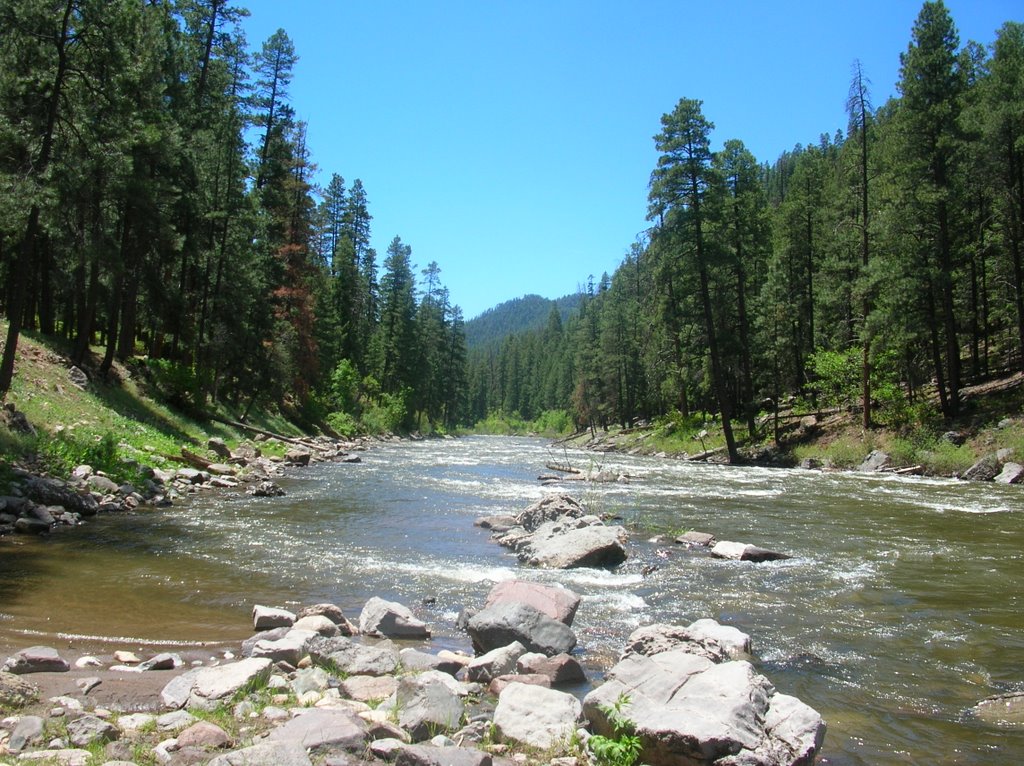
(photo:Prabhu Singh)
On November 14, begins the ninth Sikh month of Maghar. The Sikh calendar called the Nanakshahi calendar governs activities within Sikhism and is based from date of birth of the founder of Sikhi, Guru Nanak in 1469.
This month coincides with November - December of the Western/Georgian/Julian Calendar and is 30 days long.
The Guru tells us that in the month of Maghar (November/December): "... those who sit with their Beloved Husband Lord are beautiful. How can their glory be measured?
Their Lord and Master blends them with Himself. Their bodies and minds blossom forth in the Lord; they have the companionship of the Holy Saints.
Those who lack the Company of the Holy, remain all alone. Their pain never departs, and they fall into the grip of the Messenger of Death.
Those who have ravished and enjoyed their God, are seen to be continually exalted and uplifted. They wear the Necklace of the jewels, emeralds and rubies of the Lord's Name.
Nanak seeks the dust of the feet of those who take to the Sanctuary of the Lord's Door. Those who worship and adore God in Maghar, do not suffer the cycle of reincarnation ever again. ((10)) " (SGGS page 135) .....More
Contents: Top 200. 210. 220. 230. 240. 250. 260. 270. 280. 290.
210
Poh

(photo:Prabhu Singh)
Poh ( ਪੋਹ ) is the tenth month in the Nanakshahi calendar. This is a calendar system which govern activities within Sikhi. This month coincides with December - January of the Western /Georgian /Julian Calendar and this month is 30 days long. The month starts on December 14 and the season during this month is cold in Punjab (India and Pakistan} where Sikhi took birth. Many tourists from western countries visit north India during Poh as this coincides with the Christmas holidays when people in the west get holidays from schools and time off from their work.
The Guru tells us that in the month of Poh (December/January): "...the cold does not touch those, whom the Husband Lord hugs close in His Embrace. Their minds are transfixed by His Lotus Feet. They are attached to the Blessed Vision of the Lord's Darshan. Seek the Protection of the Lord of the Universe; His service is truly profitable. Corruption shall not touch you, when you join the Holy Saints and sing the Lord's Praises. From where it originated, there the soul is blended again. It is absorbed in the Love of the True Lord. When the Supreme Lord God grasps someone's hand, he shall never again suffer separation from Him. I am a sacrifice, 100,000 times, to the Lord, my Friend, the Unapproachable and Unfathomable" (SGGS page 135) .....More
Contents: Top 200. 210. 220. 230. 240. 250. 260. 270. 280. 290.
211
Magh
Magh is the eleventh month in the Nanakshahi calendar and governs the activities of the Sikhs during the Winter period and dictates events within Sikhism.
This month coincides with January/February of the Western/Georgian/Julian Calendar and is 30 days long. The month of Marg starts on the 13 of January and ends on the 11 of February.
The Guru tells us that in the month of Magh (January/February): "...let your cleansing bath be the dust of the Saadh Sangat, the Company of the Holy. Meditate and listen to the Name of the Lord, and give it to everyone. In this way, the filth of lifetimes of karma shall be removed, and egotistical pride shall vanish from your mind. Sexual desire and anger shall not seduce you, and the dog of greed shall depart. Those who walk on the Path of Truth shall be praised throughout the world. Be kind to all beings-this is more meritorious than bathing at the sixty-eight sacred shrines of pilgrimage and the giving of charity. That person, upon whom the Lord bestows His Mercy, is a wise person. Nanak is a sacrifice to those who have merged with God. In Maagh, they alone are known as true, unto whom the Perfect Guru is Merciful. ((12))" (SGGS page 135) .....More
Contents: Top 200. 210. 220. 230. 240. 250. 260. 270. 280. 290.
212
The new month of Phagun starts on the February 12 each year. This is the twelfth and final month in the Nanakshahi calendar, which governs activity within Sikhism.
In Punjab where Guru Nanak resided, this month marks the end of winter and the beginning of spring. This month coincides with February - March of the Western/Georgian/Julian Calendar and is 30 days long except in leap years when its 31 days long.
This is what the Guru Granth Sahib says about this month:
| In the month of Phalgun, bliss comes to those, unto whom the Lord, the Friend, has been revealed. The Saints, the Lord’s helpers, in their mercy, have united me with Him. My bed is beautiful, and I have all the comforts. I feel no sadness at all. My desires have been fulfilled - by great good fortune, I have obtained the Sovereign Lord as my Husband. Join with me, my sisters, and sing the songs of rejoicing and the Hymns of the Lord of the Universe. There is no other like the Lord - there is no equal to Him. He embellishes this world and the world hereafter, and He gives us our permanent home there. He rescues us from the world-ocean; never again do we have to run the cycle of reincarnation. I have only one tongue, but Your Glorious Virtues are beyond counting. Nanak is saved, falling at Your Feet. In Phalgun, praise Him continually; He has not even an iota of greed. ((13)) |
| SGGS page 136 |
Contents: Top 200. 210. 220. 230. 240. 250. 260. 270. 280. 290.
213
The word "Sikhism" is derived from "Sikh", which is a Punjabi word that means a "dedicated" and "devoted" disciple or student. It is estimated that there are about 25 million Sikhs worldwide, making Sikhism or Sikhi, the 5th largest religion in the world.
Of these 25 million Sikhs, approximately 20 million Sikhs live in India, primarily in the state of Punjab in the north west part of the sub-continent. Outside the Punjab, large populations of Sikhs can also be found in the United Kingdom, Canada, and the United States. Sikhs are a significant minority in Malaysia, Singapore and Australia. In most of the foreign countries, they have faced hardships because of their appearance but are respected for their hard work and skills.
Sikhism was founded by Guru Nanak, who was born in 1469. Nine other Gurus followed him from 1539 to 1708. The Gurus preached the same message to all the peoples of the world. They urged people of all religions or of no religion to work together in friendship. The taught that religion was a way to unite people of diverse backgrounds in the knowledge that we are all children of the same one Almighty God, the Creator, Sustainer and Destroyer. .....More
Contents: Top 200. 210. 220. 230. 240. 250. 260. 270. 280. 290.
214
Gurdwara Rori Sahib is located in Eminabad, one and half a kilometre north-west of the centre of the town. Eminabad, an old town is 15 kilometres south of Gujranwala and is a famous town of Gujranwala district in West Panjab, Pakistan.
It is linked to Grand Trunk Road and Eminabad railway station by four-kilometres stretch of metalled road. It has three important historical shrines of the Sikhs.
This sacred shrine marks the site where, according to tradition, Guru Nanak after the destruction of the town had stayed with Bhai Lalo. Here the Guru had to sit and lie on a hard bed of pebbles (small stones) ("rori" or "row-ree" in Punjabi means "pebbles") as alluded to in Bhai Gurdas Varan 1.
When the armies of Babar entered Punjab in 1521, Guru Nanak Dev was present in Eminabad. At the time of capture of Eminabad, many locals were arrested, among whom was Guru Nanak Dev Ji also. At the time of the arrest, he was sitting on the pebbles and was busy in his prayers. The Gurdwara stands at the place of the pebbles.
An imposing Gurdwara has been built over the place. A large pond and other buildings make it more graceful. A large estate worth Rs.5000 per annum and 9 squares of agricultural land is endowed to the Gurdwara from the era of Maharaja Ranjit Singh. .....More
Contents: Top 200. 210. 220. 230. 240. 250. 260. 270. 280. 290.
215
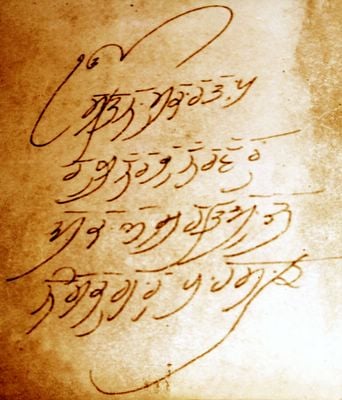
The sacred hymn called the Japji sahib consists of the Mool Mantar (the opening mantar), a set of 38 Pauris (hymns) and a final salok. This Bani appears at the very beginning of the Sri Guru Granth Sahib from Page 1 to Page 8 of the Holy Book of the Sikhs. It is regarded as the most important Bani or 'set of verses' by the Sikhs and is recited every morning by all practising faithful of this religion. The word ‘Jap’ means to ‘recite’ or ‘to ‘chant’ & implies practising this truthful path to achieve a higher aim of human life i.e. ..to understand the path to GOD. ..to achieve realisation and salvation in your life, etc.
Japji is a universal song of God composed by Guru Nanak, the founder of the Sikh faith. Japji uses the technology of "Naad" - the science of the sound current. Reciting the words of Japji, which speak of that which is beyond words to express, serves to bring the frequency of Infinity into your life. Japji is a tool designed to deliver a human being to a higher level of conciousness. Japji is a requirement for the seeker of Truth. The Sound Current of Japji and the meaning of its words, when meditated upon with openness and love, awakens a soul to its destiny. Step by step, Japji gives you the comprehensive power to know yourself as you are and be one with God's Creation in a spirit of joyful surrender and connection. .....More
Contents: Top 200. 210. 220. 230. 240. 250. 260. 270. 280. 290.
216
On September 22 every year, the Sikhs remember the passing away of Guru Nanak, the founder of their religion which is now known as Sikhism. The contribution of the Guru to our understanding of life and its deeper meaning is immense.
Why not learn more about the Guru's contributions to Sikhi and how this has benefited humanity. Guru Nanak was born on April 15, 1469 but each year, the Sikhs have chosen the full moon day in November to celebrate this momentous birthday.
Guru Nanak Dev came into this world at a time of extreme doom and gloom when the moral standards of the ruling class had vanished; the rulers had no respect for humanity; and law of the jungle prevailed everywhere. Men’s ideas and aspirations were at an all time low.
Materialistic wealth, plain greed and illusion of Maya fascinated the world and led everyone astray. Good acts and righteous behaviour no longer commended themselves to humans. They were burning with ego, pride and had no respect for others. The high and the low forgot their mutual duties. .....More
Contents: Top 200. 210. 220. 230. 240. 250. 260. 270. 280. 290.
217
The clash (7 March 1703) between Sahibzada Ajit Singh, (the eldest son of Guru Gobind Singh) and Bhai Udey Singh with a force of about 200 Singhs against the soldiers of Zabar Khan was fought at the village of Bassi Kalan (31°32`N, 75°55`E); about 10km from Hoshiarpur. Guru Gobind Singh ji had sent the Sikhs to the village to arrest Zabar Khan who had kidnapped the young Hindu bride of Devi Das, who had asked Guru Gobind Singh for help.
Hakim Jabar Khan (a Pathan) was the chieftain of the village of Bassi Kalan and 21 other Villages in Hoshiarpur District. He, like many of the Muslim landowners, used to torture the local Hindus living in the villages. Many Muslims (usually the Sunni Ghaznis and especially the Pathans) looked upon the Hindus who they called 'zimmis' (non-muslims) as less than human and often did with them as they wished. Khan would kidnap the local girls, and take them to his palace for indecent purposes.
The honor of a young woman or even of a married woman (being a virgin or having relations with only her husband was (and still is) a very important thing in Punjab. Many women, both Hindu and Sikh preffered to kill themselves rather than face the shame of being raped. Khan would even have his men snatch the wedding doli of young hindu brides so he could rape them before their marriages were consummated. .....More
Contents: Top 200. 210. 220. 230. 240. 250. 260. 270. 280. 290.
218
Singh Sabha Southall was established to challenge the very serious decline in Sikhism among the Sikhs in England, who had emigrated to the UK in the fifties and early sixties.
By the 1950's, a significant number of Sikhs were living in Britain, and the main Congregational (sangat) gathering was at Shepherd's Bush Gurdwara in West London. To accommodate the Southall Sikhs, the Southall Sikh Cultural Society was established in 1960.
The principal aims of the Society were:
- To propagate the true Sikh religion and restore it’s pristine glory.
- To edit, publish and circulate historical and religious books.
- To propagate Punjabi as the medium through writings in books, magazines and newspapers.
- To encourage reform in those who had drifted away and help them return to the Sikh Panth
- To work with the authorities to ensure their support and association with the education policies of the Sabha. .....More
Contents: Top 200. 210. 220. 230. 240. 250. 260. 270. 280. 290.
219
Baba Gurditta (15 November 1613 - 1638), was the eldest son of the sixth Sikh Guru, Guru Hargobind. He was born on 15 November 1613 to Mata Damodari at Daroli Bhai, District Firozpur in Punjab, India.
He was also an elder brother of Guru Tegh Bahadur, the ninth Sikh Guru and the father of Guru Har Rai and Dhir Mall. He was married to Mata Nihal Kaur. He had his training in religious lore and in the martial arts under the supervision of his father.
A beautiful Gurdwara stands at this site called Gurdwara Daroli Bhai, Dist. Firozpur. This Gurdwara marks the birthplace of Baba Gurditta, who was a great saint. The family of Guru Hargobind's wife Mata Damodari still live here and are custodians of some rare personal belongings of the sixth Sikh Guru, Guru Hargobind as well as a handwritten copy of Sri Guru Granth Sahib bearing the personal seal of Guru Gobind Singh. Similarly there is also an another Gurudwara at Anandpur Sahib of Baba Gurdita on a small hill nearby. .....More
Contents: Top 200. 210. 220. 230. 240. 250. 260. 270. 280. 290.
220
Takhat Sri Damdama Sahib, Talwandi Sabo, Bhatinda, is the fifth "seat of authority" (Takhat) of the Sikhs. Literally, "Damdama" means "having a break or rest".
This sacred shrine is located at village Talwandi Sabo, 28 km southeast of Bathinda in southern Punjab, India.
It was declared as the fifth Takhat by the government of India in April 1999 during tercentennial celebrations of the advent of Khalsa.
This place owes its importance to the literary work of Guru Gobind Singh done here during his stay in 1705-6. It was at Damdama Sahib that Guru Gobind Singh prepared the revised and final version of the Adi Granth, the initial Sikh holy scripture.
The completed volume is the same scripture which is now honored by the Sikhs as their perpetual "spiritual teacher" or Guru and is called the holy Sri Guru Granth Sahib. The Guru added to the original version prepared by Guru Arjan Dev the verses of his father, Guru Teg Bahadur. The Damdame Wali Bir (Damdama Sahib volume) as it is sometimes called was completed here. The entire volume was transcribed by Bhai Mani Singh while the Guru dictated it verbally. .....More
Contents: Top 200. 210. 220. 230. 240. 250. 260. 270. 280. 290.
221
On 19 March every year, the Sikhs commemorate the passing away of their sixth Master, Guru Har Gobind (5 July 1595 - 19 March 1644).
The Guru Sahib was born at village Guru Ki Wadali in district Amritsar on 5 July 1595 and was the only son of Mata Ganga and Guru Arjan, whom he succeeded on 11 June 1606 at the age of only 11 years old.
The young Hargobind received his early education and training from the revered Sikhs leaders of the time Baba Buddha, the first granthi and Bhai Gurdas, the scribe of the Sikh holy script, Guru Granth Sahib.
Guru Hargobind was married in about 1610 to Mata Nanaki also known as Mata Marwahi or Mata Mahadevi. They were endowed with a large family consisting of one daughter Bibi Viro and five sons: Baba Gurditta, Suraj Mal ji, Ani Rai ji, Atal Rai ji and Tegh Bahadar ji.
Guru Hargobind was responsible for wearing two kirpans - one for Miri (temporal protection) and one for Piri (spiritual reasons) and began the rapid and irreversible militarization of the Sikh people. It was due to the tragic martyrdom of his father, Guru Arjan that the sixth Guru changed the Panth into an effective, brave and determined army of religious supporters. .....More
Contents: Top 200. 210. 220. 230. 240. 250. 260. 270. 280. 290.
222
Guru Hargobind fought his first battle at the present day site of Khalsa College in 1634 and was victorious.
The Guru was about to celebrate the marriage of his only daughter Bibi Viro when he was attack by the Mughals.
A force of 700 Sikhs defeated an army of Mughal troops believed to 7,000 strong. The foundation stone of Khalsa College was laid in 1892 and it has since been one of the eminent Sikh educational institutions.
This famous college is a historic educational institution in the northern Indian city of Amritsar in Punjab state. Founded in 1892, the sprawling 300-acre campus is located about eight kilometres outside of the city centre on the Amritsar-Lahore highway (part of the Grand Trunk Road), adjoining Guru Nanak Dev University campus, to which Khalsa College is academically affiliated.
Khalsa College Establishment Committee was set up in 1890 with Colonel W. R. M. Holroyd, Director of Public Instruction, Punjab, as president, and W. Bell, Principal of Government College, Lahore, as secretary. Among the native constituents of this 121-member committee were Sir Attar Singh, Gurdial Singh Maan of Nabha, Diwan Gurmukh Singh of Patiala, Bhai Kahn Singh, Professor Gurmukh Singh and Sardar Jawahir Singh (1859-1910).
Many princely states of British India gave their financial help for the establishment of this College, including Maharaja Rajendra Singh of Patiala, .....More
Contents: Top 200. 210. 220. 230. 240. 250. 260. 270. 280. 290.
223
Giani Ditt Singh was a scholar, poet, editor and an eminent Singh Sabha reformer. He was born on April 21, 1853 at village Kalaur in the district of Fatehgarh Sahib, Punjab India.
Having moved from one centre of learning to another, Ditt Singh became knowledgeable enough to hold in-depth discussions with eminent religious scholars like Sadhu Dayanand and others. It is worthwhile to look at some of these discussions; one of these appears below.
"Arya Samaj" was, initially, an institution which was working towards the removal of casteism and ritualism. Giani ji along with Bhai Jawahar Singh joined this movement. Swami Dayanand was the torch-bearer of this movement. However, Giani ji soon found that the Arya Samaj Chief, Swami Dayanand’s belief in the supremacy of Vedas was overwhelming as was the similar assertion made by the Muslims regarding the holy Koran.
The Swami did not believe in the existence of any other religion apart from Hinduism. This was, again, a narrow parochial approach to the multi-cultural and multi-religious societies of the world. Both Bhai Jawahar Singh and Giani Ditt Singh planned to set things right. .....More
Contents: Top 200. 210. 220. 230. 240. 250. 260. 270. 280. 290.
224
On April 21,1913, the Indians of California assembled and formed the Ghadar Party (Revolution Party).
The aim of the Ghadar Party was to get rid of the slavery caused by the British for the people of India. The British had been ruling India as a colony of the British Empire for over 100 years.
The Ghadar Party's aim was to rid of the colonial super-power by means of an armed struggle and to set up a national democratic government on the sub-continent. Their slogan was "Put at stake everything for the freedom of the country."
On the November 1, 1913, the Ghadar Party started printing a paper named 'Ghadar', which was published in the Punjabi, Hindi, Urdu, Bengali, Gujarati and Pushto languages. Kartar Singh Sarabha did all the work for that paper.
This paper was sent to Indians living in all countries throughout the world. The purpose of the paper was to unmask the ugly truth about British rule to all Indians, impart military training to volunteers, and explain in details the methods of making and using weapons and explosives. Within a short time, the Ghadar Party became very famous through its organ: 'The Ghadar". It drew Indians from all walks of life.
Kartar Singh Sarabha began his involvement in the Gadar Party in San Francisco in 1912. .....More
Contents: Top 200. 210. 220. 230. 240. 250. 260. 270. 280. 290.
225
As soon as the war broke out in early August 1914, the British and the French quickly mobilized their respective empires. Soldiers and labourers from all over the world soon found themselves on the Western Front.
More than 30 different nationalities were engaged in the Ypres Salient. There was a British Indian infantry division composed of three brigades with four battalions that quickly grew to five battalions after the battle of Neuve-Chapelle in April 1915.
Undoubtedly the British forces were composed of soldiers of the world’s greatest ever empire in 1914. Firstly, there were the Dominions; Canada, Australia, New Zealand and South Africa in addition to the crown colonies of Newfoundland and, of course, our main subject today - the Sikhs from British India.
It is now quite obvious that even though they were united in a common cause, a uniform sense of nation was, at the time and even up to the partition of India, blatantly absent.
The then troops of the British Indian army or the British Indian Labour Corps came from, what is today, the countries of India, Pakistan, Bangladesh, Burma and Nepal.
Even some smaller constituent parts of the British Empire sent their sons to Flanders’ fields, Egypt (Egyptian Labour Corps), BWI (the Caribbean and mainly Jamaica, Trinidad & Tobago and Barbados) and Bermuda, the Fiji Islands (Fijian Labour Corps). Then again, the British army counted white Rhodesians amongst its ranks. .....More
Contents: Top 200. 210. 220. 230. 240. 250. 260. 270. 280. 290.
226
Hari Singh Nalwa (1791-1837), celebrated General of Maharaja Ranjit Singh, was born in April 1791, at Gujranwala, now in Pakistan, to Gurdial Singh, an Uppal Sikh of the Sukerchakia Misl.
The family originally came from Majitha, near Amritsar. His grandfather, Hardas Singh, had been killed fighting against Ahmad Shah Durrani in 1762. His father, Gurdial Singh, had taken part in many of the campaigns of the Sukkarchakkias Charat Singh Sukkarchakia and Mahari Singh.
Hari Singh Nalwa was the Commander-in-chief at the most turbulent North West Frontier of Ranjit Singh's kingdom. He took the frontier of the Sarkar Khalsaji to the very mouth of the Khyber Pass. For the past eight centuries, marauders, who had indulged in looting, plunder, rape, and forcible conversions to Islam had used this route into the subcontinent.
In his lifetime, Hari Singh became a terror to the ferocious tribes inhabiting these regions. He successfully thwarted the last foreign invasion into the subcontinent through the Khyber Pass at Jamrud, permanently blocking this route of the invaders. Even in his death, Hari Singh Nalwa's formidable reputation ensured victory for the Sikhs against an Afghan force five times as numerous.
Hari Singh Nalwa's performance as an administrator and a military commander in the North West Frontier remains unmatched. Two centuries on, Britain, Pakistan, Russia and America have been unsuccessful in effecting law and order in this region. Hari Singh Nalwa's spectacular achievements exemplified the tradition established by Guru Gobind Singh such that he came to be hailed as the "Champion of the Khalsa". .....More
Contents: Top 200. 210. 220. 230. 240. 250. 260. 270. 280. 290.
227
| ਸਚਹੁ ਓਰੈ ਸਭੁ ਕੋ ਉਪਰਿ ਸਚੁ ਆਚਾਰੁ ॥੫॥ |
| Sacẖahu orai sabẖ ko upar sacẖ ācẖār.(5) |
| Truth is high but higher still is truthful living.(5) |
The quote above is an important saying of the founder of Sikhi, Guru Nanak, the first Sikh Guru. Most religions revere the Truth. Hinduism tells us that truth is ever triumphant. “Ye shall know the Truth and Truth shall make you free,” promises the Bible. Guru Nanak, too, reminds us that “Truth is the panacea of all ills,” and that “Truth is high but higher still is truthful living.” God's name, according to Sikhi is said to be the "Truth".
The Guru wants us to realise that God watches us all the time and that our lives are spent under His constant gaze. Just like a mother watches a small baby, the Lord watches us all. "He created all, and He Himself watches over us. Some are close to Him, and some are far away." (SGGS p 38) The way we behave in our life brings us near or takes us away! Only by following the path of truthfulness can one get nearer to the Lord. .....More
Contents: Top 200. 210. 220. 230. 240. 250. 260. 270. 280. 290.
228
Pandit Kirpa Singh Dutt (d. 1705) was the son of Bhai Aru Ram, a Sarasvat Brahmin of Matan, 65 Km east of Srinagar, in Kashmir. Aru Ram had met Guru Har Rai and sought his blessing at the time of the latter's visit to Kashmir in 1660.
A group of Kashmiri brahmins came to Guru Tegh Bahadar at Anandpur sahib in May 1675 to seek the Guru's protection against atrocities of Aurungzeb. Kirpa Ram led this group of Kashmiri Pandits (educated scholars) driven to dire straits by the State persecution of non-Muslims.
They had faced stiff taxes, atrocities, cruelty and repression under the Mughal governor of Kashmir. Honour of their daughters was being lost and they were losing their religion to the fanatic zeal and proselytization activities of Islamic crusaders.
Iftikhar Khan, governor of Kashmir (1671-1675) was a harsh man and was making forcible conversion to Islam of all non-Muslims. The Kashmiri Brahmins asked the Guru for a solution. Guru replied "Such activities can only be stopped by the sacrifice of a great person".
Just then 8 years old son of Guru Tegh Bahadar, Gobind Rai (later named Gobind Singh) walked into the meeting to find his father lost deep in thoughts. .....More
Contents: Top 200. 210. 220. 230. 240. 250. 260. 270. 280. 290.
229
Peer Buddhu Shah (13 June 1647 - 21 March 1704), a Muslim divine whose real name was Badr ud Din, was an admirer and ally of Guru Gobind Singh.
He was born on 13 June 1647 in a prosperous Sayyid family of Sadhaura, in the present-day Ambala district of Haryana. Because of his simplicity and silent nature during his early childhood he was given the nickname of Buddhu (literally meaning "simpleton") which stuck to him permanently.
He was married at the age of 18 to a pious lady, Nasirari who is better known as Bibi Naseera. She was the sister of Said Khan a high ranking officer in the Mughal army. Peer Buddhu Shah had four sons Sayyed Ashraf, Sayyed Muhomad Shah, Sayyed Muhomad Baksh and Sayyed Shah Hussain.
It is not certain how Buddhu Shah first became acquainted with Guru Gobind Singh, but it is recorded that he called on him in 1685 at Paonta, on the bank of the Yamuna. While Guru Gobind Rai was staying at Paonta, the Pir was touring the hilly areas. The Pir came to know that Guru Gobind Rai, the tenth embodiment in the line of Guru Nanak, was staying at Paonta. .....More
Contents: Top 200. 210. 220. 230. 240. 250. 260. 270. 280. 290.
230
When Guru Nanak first began to preach his message, it was not with the intention of starting a new religion. He was such a gentle person, full of selflessness and humility that it was not in his nature to arrogate to himself the position of a leader. He never stopped to think or calculate about the impact on the world which his teaching would make. He was, as he often asserted himself, a humble servant of God and he was only concerned with doing God's will in the world; with suggesting practical ways of countering the evil, ignorance and superstitions which had taken hold of the Religions of India.
Guru Nanak was, in fact, primarily concerned with the spiritual welfare of the common people. He understood well enough the complicated beliefs, religions and philosophies currently held by the Brahmins, various holy men and Muslim quazis (Qazis), and he could converse and argue with them on equal terms. However, religion, he believed should be equally accessible to the ordinary man, the simple potter, the peasant, the shopkeeper or even the lowest outcasts. Therefore, Guru Nanak taught only one simple belief, and only one simple religious practice which, once imbibed into the heart of a sincere devotee, could save him from all evil and temptation. The belief was in the One-ness of God, the Creator, and the practice was in the constant remembrance of His Name, with the ultimate aim of achieving salvation.
Like the people of ancient times, the common people of Guru Nanak's day paid tribute to a number of minor gods and goddesses, which were part and parcel to Hinduism. They were attached to these beliefs in superstitious bondage, from fears evolved over the centuries, fears which had no relation at all to religion as such. .....More
Contents: Top 200. 210. 220. 230. 240. 250. 260. 270. 280. 290.
231
| ਜਬ ਹਮ ਹੋਤੇ ਤਬ ਤੂ ਨਾਹੀ ਅਬ ਤੂਹੀ ਮੈ ਨਾਹੀ ॥ |
| Jab ham hoṯe ṯab ṯū nĝhī ab ṯūhī mai nĝhī. |
| When there is me, God is not there. Now there's only you, Ego has vanished! |
When there is ego, there is no God; when there is God, there is no ego!
If one needs to be near God, then one has to remove one's ego. Ego is a barrier to the path that leads to the Lord.
Ego which in Punjabi is referred to as Ahankar represents the feeling of excessive pride or acute self-importance.
An individual may feel excessively proud due to many things - due to one's enormous number of worldly possessions, one's outstanding beauty or attractive physical appearance, personal talents, material wealth, mental intelligence, superior spirituality, authoritative powers, great charity work, etc.
Sikhism requires one to shed this internal evil. Sikhs believe that this negative trait can be subdued by engaging in community service and by meditation or engaging in simran. Engaging in community work reduces the feeling of self-importance and brings respect for the community spirit.
The tradition of free selfless service for society and the community with Nimrata or humility is well established in Sikhi. .....More
Contents: Top 200. 210. 220. 230. 240. 250. 260. 270. 280. 290.
232
Sikhism was established by ten Gurus, human spiritual teachers or masters, over the period from 1469 to 1708 - that is over a period of 239 years. These teachers were enlightened souls whose main purpose in life was the spiritual and moral well-being of the masses.
By setting an exceptional example of how to live a holy and worthy life through practising righteous principles of living their human lives, they sort to awaken the higher conciousness in the human race. The Gurus taught the people of India and beyond, to live spiritually fulfilling lives with dignity, freedom and honour.
Each of the ten masters added to and reinforced the message taught by the previous, resulting eventually to the creation of the religion that is now called Sikhism. Guru Nanak Dev was the first Guru and Guru Gobind Singh the final Guru in human form. When Guru Gobind Singh left this physical world, he made the Sri Guru Granth Sahib the ultimate and final Sikh Guru. The Spirit of this final Guru is more than a holy book for the Sikhs, who give this eternal Guru the same respect and reverence as a living "human" Guru.
During the span of 239 years from 1469 to 1708, the Sikh Gurus laid down within the sacred scriptures, the rules and regulations that outline the way of living that was to be followed by all practising disciple of this religion. The history and the literature present the followers of the faith with the raw material required to learn about the beliefs and practises propagated by the Gurus.
The Gurus were clear also to outline rituals, practises and beliefs that were not appropriate and were not to be followed by the faithful disciples. Perhaps, Sikhi is unique among world religions in that it has ten masters who created and were responsible for the birth of the faith while most others religions just had one master, prophets or leader? .....More
Contents: Top 200. 210. 220. 230. 240. 250. 260. 270. 280. 290.
233
One evening, we had just finished doing kirtan at Gurdwara Singh Sabha, Slough. A Singh phoned and said he had booked kirtan in Hounslow, and we should come straight away. Bhai sahib said, "Lets go quickly, we should always be on time".
As Bhai Jeevan Singh sahib, his singhni (wife), myself and another youth walked downstairs into the joorian (shoes) section. A mona (man with hair cut) was walking in to the Gurdwara. Accidentally, he bumped into Bhai sahib. He said "sorry," and looked in to Bhai sahib's face. Those who know Bhai sahib know how enigmatic his smile is, and how his face always shone.
Bhai sahib said to him, "I came here especially to see you, I have something for you." Bhai sahib then took off his dastaar (turban) and handed it to the youth. The mona youth could not believe his eyes; Bhai sahib said these words to him with so much honesty, pyaar (lovingness) and humility. From that day on, that once "mona" Sikh kept his kesh and came into Sikhi.....
When Professor Manjit Singh was the Jathedar {leader) of the Akal Takhat Sahib. He called a World Sikh Smagam (gathering, conference), which is basically a gathering of "Sarbat khalsa". Every Gurdwara, Sikh group and jatha from around the world were invited and many days were spent discussing Panthik (concerning the Sikh path or Panth) issues at the Siri Akal Takht Sahib. All Panthik matters were discussed. Thousands of Sikhs gathered, including all the luminaries of the Panth. .....More
Contents: Top 200. 210. 220. 230. 240. 250. 260. 270. 280. 290.
234
Gurdwara Dera Baba Nanak is situated in the city Dera Baba Nanak which is located in Gurdaspur District of Punjab, India. It is about 1 kms from the Indo-Pakistan border and on the east bank of River Ravi. To its west is located the town of Kartarpur (Ravi) which is located in Pakistan.
As its name implies, this shrine is connected with Guru Nanak, the founder of Sikhi. The Guru used to meditate on God by the well called "Ajita Randhawa da khooh" after his first udasi in 1506. On the stage situated in the Gurdwara sahib, Guru Ji had discussion with Ajita Randhawa.
Guru Nanak, the first master, spent the last days of his temporal life at Gurudwara Dera Baba Nanak. The exact location of Gurdwara Dera Baba Nanak is on the left (or east) bank of Ravi River adjacent to the present-day Indo-Pak border. Guru Nanak Dev used to visit this site for meditation.
On the right (or west) bank of river Ravi Guru Nanak Dev founded the city of Kartarpur. At the age of seventy, Guru Nanak Dev Ji left for his heavenly abode from here. The Gurdwara marking the location of the Guru's heavenly departure is in the territory of Pakistan. However, you can see it standing ashore the East bank of River Ravi or from the town Dera Baba Nanak at a distance of about 4 or 5 Kms across the border line. .....More
Contents: Top 200. 210. 220. 230. 240. 250. 260. 270. 280. 290.
235
Sirhind the town located in Punjab India, which was the unfortunate witness to the the martyrdom of the two younger sons or chotta sahibzada of Guru Gobind Singh in 1704. Wazir Khan, the Governor of Sirhind, had vowed to finish off the Sikhs root and branch.
The two younger sons of Guru Gobind Singh, Baba Zorawar Singh who was age 9 years and Baba Fateh Singh who was aged 6 years, were bricked alive on Wazir Khan's orders when the sahibzade had refused to embrace Islam in 1704 at this unfortunate city. The Sikhs were keen to avenge the killings of such young lives by such a evil tyrant and an oppressor of the people of India. Thankfully, some 6 years later, on May 27, 1710, Banda Singh Bahadur announced to the city of Sirhind the end of the tyrannical Mughal rule.
It was 2 years earlier, in 1708, that a chance meeting took place between Lachman Das, later known as Banda Singh Bahadar and Guru Gobind Singh, on the banks of the Godavari River. The Guru sent Banda Bahadur to Punjab to suppress the tyranny of the then rulers and punish Wazir Khan. In October, 1708, Banda set off from Nanded towards Punjab along with a band of 5 Sikhs and a hukamnama, which enjoined upon the Sikhs to assemble under his banner. As Banda reached Delhi, thousands had gathered under his command. .....More
Contents: Top 200. 210. 220. 230. 240. 250. 260. 270. 280. 290.
236
Raja Hari Chand was one of the twenty two hill chiefs who once boasted that if he ever came face-to-face with Guru Gobind Singh Ji on the battle field his one arrow would be enough to kill him. It so happened that when some of the hill chieftains turned against Guru Sahib Ji and sided with the Mughal forces that Raja Hari Chand found himself face-to-face with Guru Sahib Ji on the battlefield.
In the raging battle Guru Sahib Ji shouted out to him "Hari Chand, here I am. Strike me if you can, you may feel sorry afterwards that Gobind Singh did not give me a chance to test my prowess in archery." Upon this, Hari Chand drew his arrow hard and shot it at Guru Sahib Ji with all his might. .....More
Contents: Top 200. 210. 220. 230. 240. 250. 260. 270. 280. 290.
237
The caste system is the name given to a system of discrimination (known as casteism) that has been practised in India for 1000s of years. It is similar to any other system of discrimination in that it involves giving different rights to people of different background.
In this case, it involves the social stratification and social restrictions of different tribes and sects within the Indian subcontinent, in which social classes are defined by thousands of endogamous hereditary groups, often termed as "jĝtis" or "castes".
It is a form of systematic discrimination just like racism: which is discrimination based on the persons race or ethnicity. In the West, before the 19th century, the evil of racism led to the organised trade in slaves and resulted in the huge amount of misery to the peoples of Africa.
Although the caste system is generally identified with Hinduism, it was also observed among followers of other religions in the Indian subcontinent, including some groups of Muslims and Christians. The Indian Constitution has outlawed caste-based discrimination, in keeping with the socialist, secular, democratic principles that founded the nation. Caste barriers have mostly broken down in large cities, though they persist in rural areas of the country. Nevertheless, the caste system, in various forms, continues to survive in modern India and elsewhere strengthened by a combination of unchanging social perceptions and warped cultural practises. .....More
Contents: Top 200. 210. 220. 230. 240. 250. 260. 270. 280. 290.
238
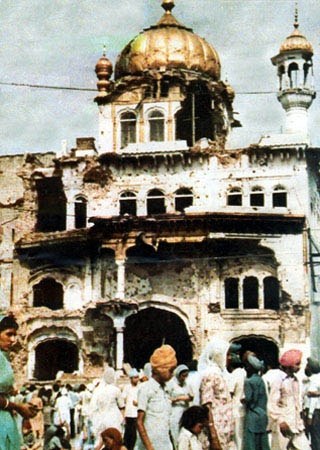
Operation Blue Star was the codename for the attack on the Akal Takhat and the Golden Temple complex during the period June 1 to 6, 1984. This tragic event took place over 25 years ago and Sikhs all over the world will remember this episode with great sadness.
The Indian army invaded the Harmandir sahib complex on the orders of the then Prime Minister of India, Indira Gandhi. At the time of the operation, close to 100,000 army troops had been deployed throughout Punjab.
A group of Sikhs, led by Jarnail Singh Bhindranwale (the charismatic leader of the Damdami Taksal) had, after being expelled from one of the Niwas (guest houses) moved into the Akal Takhat.
Besides the historic weapons carried by Sikhs, the kirpans and khandas, the group which had fortified the historic Takhat, with rifles, assault weapons & grenades, numbered no more than 250. The Golden Temple, the surrounding Bungas, guest houses and Langar were filled with 2,000 or more pilgrims, guests and employees of the complex. Many had come to visit the Temple on the day associated with the Martyrdom of Guru Arjan. .....More
Contents: Top 200. 210. 220. 230. 240. 250. 260. 270. 280. 290.
239
Baba Banda Singh Bahadur (16 October, 1670 - 9 June, 1716) (Lachhman Dev alias Madho dass Bairagi), originally from the Jammu region in Northern India, is revered as one of greatest Sikh warriors as well as a most hallowed martyrs of the Khalsa Army.
The Khalsa were engaged in a prolonged fight against the cruel Mughals, who were practising their tyranny and terrorism. His confrontation with the Mughal administration in Northern India, though brief, was strong and vigorous enough to shake the foundations of this evil empire.
The agrarian uprising that he led in the Punjab was the underpinning on which the Dal Khalsa, the Sikh Misls and Maharaja Ranjit Singh built the edifice which finally culminated with Ranjit Singh capturing Lahore in 1799 and establishing the Sikh Kingdom of the Punjab; that resulted in the end of a dark period in the history of India.
Banda was born in a Minhas Rajput family on October 16, 1670 at Rajouri in the Jammu region of Jammu and Kashmir. He was named Lachman Dev. Wrestling, horseback riding, and hunting were his major hobbies. He was a very active and energetic child. .....More
Contents: Top 200. 210. 220. 230. 240. 250. 260. 270. 280. 290.
240
Bhai Vir Singh (5 December, 1872 - 10 June, 1957) was a poet, scholar and theologian who was a major figure in the movement for the revival and renewal of Punjabi literary tradition.
His identification with all the important concerns of modern Sikhism was so complete that he came to be canonized as Bhai, the Brother of the Sikh Order, very early in his career. For his pioneering work in its several different genres, he is acknowledged as the creator of modern Punjabi literature.
Born on 5 December 1872, in Amritsar, Bhai Vir Singh was the eldest of Dr Charan Singh's three sons. The family traces its ancestry back to Diwan Kaura Mall Arora (d.1752), who rose to the position of vice-governor of Multan, under Nawab Mir Mu'ln ul-Mulk, With the title of Maharaja Bahadur. Bhai Vir Singh was married at the age of 17 to Chatar Kaur, daughter of Sardar Narain Singh of Amritsar.
Considered to be the harbinger of modern Punjabi literature, Bhai Vir Singh wrote many books,prose, novels, poety, plays, historical research, novels and articles pertaining to the Sikh history, Gurbani and understanding of the Sikh principles. .....More
Contents: Top 200. 210. 220. 230. 240. 250. 260. 270. 280. 290.
241
On June 1,1984, my brother Surinder and I were moved out of Punjab as the borders were being sealed and a curfew was declared in Punjab. Further, there was a news blackout. That only meant we had to infiltrate and see exactly what was going on.
So after two weeks, we set off in disguise. Upon approaching Amritsar, the truck we were riding in was waved to a stop and all of us were ordered out. I had already fastened my tape recorder with gaffer's tape to the small of my back. And I had tucked my 16mm Bolex camera into a filthy old jhola (cloth bag). When I raised my arms, a soldier patted me down but missed the tape recorder, and when he spun me around, I shifted the jhola quickly so he didn't see it under my shawl, and off we went to see what destruction Mrs. Gandhi had created.
Tanks and submachine guns and barbed wire greeted us at the Golden Temple. We circled around to the medieval streets in the back. Crooked winding lanes were dotted with Gurkha Regiment guards, imported because their foreignness would imply that they would not be taking sides in what was clearly the most traumatic event to have taken place in our lifetime in India.
"The police hacked off the arms of people and we collected their torsos in gunny sacks," said one of the residents who dared to greet us in the empty streets. He spoke in Punjabi, into my tape recorder. For half an hour, we interviewed him as he described the utter carnage of three days of gruesome battle that is now known with the rather beautiful name Operation Blue Star.
Contents: Top 200. 210. 220. 230. 240. 250. 260. 270. 280. 290.
242
On 5 August every year, the Sikh community commemorate the "Barsi" (Death Anniversary) of late Bhagat Puran Singh (1904 - 1992).
Bhai Sahib was born at Rajewal, in district Ludhiana, Punjab, India on June 4, 1904. His mother was Mehtab Kaur and his father's name was Chaudhari Chibu Mal. Bhai Sahib was born into a Hindu family and his original name was Ramji Das.
He started his education at Khanna, Punjab and then later joined Lahore's Khalsa High School. As a young man, he used to perform "sewa" at Gurdwara Dera Sahib and Gurdwara Shahid Ganj in Lahore.
Here, he would help with cleaning, cooking and serving food; he also tended to the aged, infirm and sick who came to the Gurdwaras to pay their respect to Guru Granth Sahib.
In an interview with Bhai Patwant Singh, Bhagat Puran Singh discloses how he became a Sikh. In his early life he used to travel a lot from village to village and would stay overnight at a Hindu Temple. One day when he was staying at one such temple, the Brahmins told him to clean the temple and then when he had done that, they sat in front of him and started eating food without offering him anything. .....More
Contents: Top 200. 210. 220. 230. 240. 250. 260. 270. 280. 290.
243
Harimandir Sahib is the most famous Sikh Temple or Gurdwara in the world. It is also called the Golden Temple in English because of the gold plating that covers most of its surface. This Gurdwara is found in the holy city of Amritsar in Punjab in North West India and is the sacred and the most visited of the many historic Sikhs shrines found in India and Pakistan. This striking building was built by the Guru Arjan Dev, the fifth Guru of the Sikhs.
For details of the Gurdwara itself see Gurudwara Harimandir Sahib. This articles deals with the area outside the Gurdwara precinct and immediate surrounding the holy shrine. It deals with the other Gurdwaras and places of interest found just outside the perimeter wall of the Gurdwara. .....More
Contents: Top 200. 210. 220. 230. 240. 250. 260. 270. 280. 290.
244
The indiscriminate brutal killing, jailing and abusing of innocent Sikhs in Delhi and other major Indian cities following the death of Prime minister, Indira Gandhi on 31 October 1984, should be a reason for great shame and sadness for the authorities and politician of India and for all people of the nation.
It defeats belief, that in a civilised society, during the modern era, that Sikhs who are a section of the community; a small minority at that, can be blamed and summarily punished without any trial or open examination, for the evil actions of just two individuals; this is absolutely beyond comprehension or understanding; it is behaviour belonging to the Stone Age.
Shame on you, India! You may have made some material progress in the last sixty years but the standards of justice and fairness in your country definitely belong to the dark ages.
This horrible event clearly highlights the very low level of morality, the non-existent level of spiritual awareness, a complete lack of compassion and .....More
Contents: Top 200. 210. 220. 230. 240. 250. 260. 270. 280. 290.
245
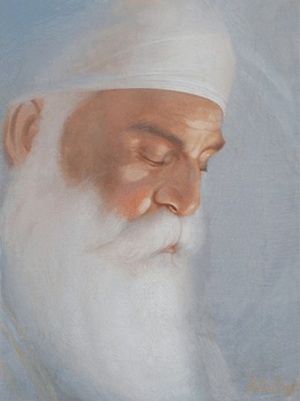
What is Sikhism? Sikhism is a way of life; a disciplined mode of living coupled with a belief in the presence and unity of one God, the equality of all mankind, dedicated faith in the Guru's word and love for all of humanity.
The stepping stone for a Sikh is to accept the one God and remember Him with ones mind and acknowledge Him through ones daily actions. A Sikh puts his trust in God alone rather than in other beings, relatives, wealth or possessions.
To act in His name and gradually reach a stage where, as the Guru says, "Water mingles with water and light merges in the light, discarding their separate existence."
Originality and clarity of the Sikh faith was instrumental in promoting it from its inception in about 1499 and the voluntary adoption by the masses with eagerness and whole-heartedness. "Keep the message simple" appears to be the common thread throughout Sikhi concepts. Simran - meditating and remembering the Creator and Seva - willingness to give ones labour for free - are the bedrocks of Sikhi. If you cannot focus your mind on the Lord; see God in all; believe in the Creator, then the journey is going to take a little longer. .....More
Contents: Top 200. 210. 220. 230. 240. 250. 260. 270. 280. 290.
246
The Battle of Amritsar took places between Guru Hargobind and the Mughal forces and was fought on 5 June 1628 (22 of Jeth, in Bikrami 1685). This was the first battle fought by the Sikhs.
Mughal Emperor, Jahangir had died in 1627 with his son Shah Jahan becoming his successor. Adding to Shah Jahan's worries over the increasing influence and power of the Sikhs, those who harboured ill-will against the Sikhs renewed their conspiracies and incited him to turn against Guru Ji.
The battle started due to a minor event that took place in the jungle about 5 miles to the south of Amritsar. It all began with the capture of a rare white Baz (hawk) which had been a gift to Shah Jahan from the Shah (Emperor) of Persia. The hawk was at the time one of the royal symbols of authority.
Shah Jahan and some of his companions were hunting in the territory around Gumtala village near Amritsar at the same time as some of the Guru's Sikhs. .....More
Contents: Top 200. 210. 220. 230. 240. 250. 260. 270. 280. 290.
247

by Guru Arjan
A cousin of Guru Ram Das came to Amritsar from Lahore especially to ask Guru Sahib to attend his son's wedding. Guru ji said, "I will not be able to go because I can't leave my duties here as Guru. Perhaps I can send one of my sons instead."
Guru Ram Das ji had three sons: Baba Prithi Chand or Prithia, Baba Mahadev and Arjan Mal. Prithia was in charge of collecting donations, of which he secretly took a portion for himself. When the Guru asked him to attend the wedding, Prithia said, "I have to take care of the collections. And I hate going to weddings."
Actually, he was afraid if he were away from the Guru for too long, he might not be appointed the Guru's successor. Having no luck with Prithia, Guru Ji then turned to Mahadev. Mahadev lived his life in meditation and said, "I have no desire to involve myself in worldly affairs."
Finally, Guru Sahib asked Arjan if he would go. Arjan said, "I only desire to do what you wish." Guru ji was very pleased. He asked Arjan to spend some time in Lahore to share the Guru's teachings with the Sikhs there. Any donations he received were to be given to the free kitchen to feed the poor. The last words he said to Arjan were, "You should stay in Lahore until I send for you by letter." .....More
Contents: Top 200. 210. 220. 230. 240. 250. 260. 270. 280. 290.
248
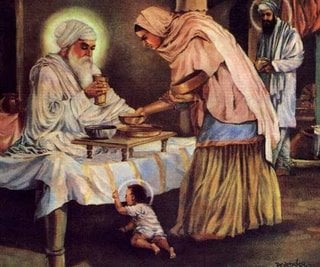
Bibi Bhani ji (1535 - 1598) was born to Guru Amar Das and Mata Mansa Devi on 19 January 1535 (21 Magh 1591 Bk) at Basarke Gillan, a village some 13 kms south-west of Amritsar. She had an older sister called Bibi Dani and two brothers called Bhai Mohan and Bhai Mohri.
She was married on 18 February 1554 to Bhai Jetha (who later became Guru Ram Das), a Sodhi Khatri from Lahore. Bhai sahib later moved to Goindval which was an upcoming Sikh town and carried out voluntary service (Sewa) in the construction of the Baoli Sahib (deep walk-in well).
When Guru Amar Das had first seen Bhai Jetha, he had been very impressed with the dedication to the sangat (congregation) and the Sewa performed by him. And so observing the purity of his kind soul, a marriage was arranged between Bibi Bhani, Guru ji's daughter and the dedicated devotee, Bhai Jehta. After marriage, the couple remained in Goindval serving the Guru, doing sewa and serving the (sangat).
Later, on the near completion of the Gurdwara at Goindval, Bhai Jetha was deputed by the Guru to go and establish a habitation at present-day Amritsar. This place was also later called "Ramdasar". Here, on a piece of land gifted, according to one version, to Bibi Bhani by Emperor Akbar at the time of his visit to Guru Amar Das, Jetha ji expanded a natural pool into a Sarovar. .....More
Contents: Top 200. 210. 220. 230. 240. 250. 260. 270. 280. 290.
249
The old saying "An Eye for an Eye and a Tooth for a Tooth" is world famous and unfortunately this quotation is still frequently followed and practised by many individuals and societies around the planet. These folks consider revenge as sweet recourse for any wrong done on them.
To act in vengeance for any wrong done has been considered the right way to live their lives. For any wrong done, they will do a similar or in most cases a bigger wrong; this reaction takes place frequently and is automatic; without any thought or consideration; to these folks it is the norm to be followed.
But as Martin Luther King Jr. said, "That old law about "an eye for an eye" leaves everybody blind. The time is always right to do the right thing."
If we think carefully about this, then in a society which practises this principle of "an eye for an eye", one injury will create a "domino effect"; and you know what happens in a domino reaction. Wikipedia defines domino effect as "a chain reaction that occurs when a small change causes a similar change nearby, which then will cause another similar change, and so on in linear sequence" until, I presume, there is nothing left nearby!
So, yes, if everyone follows this commendation, then all of us will end up totally blind when a single injury has been inflicted by anyone! Is this a Sikhi thing to do? .....More
Contents: Top 200. 210. 220. 230. 240. 250. 260. 270. 280. 290.
250
Shabad Hazaarae is the Bani of longing for the beloved Guru. It was written by Guru Arjan when he was separated from Guru Ram Das, his father for a duration of time.
During that period of separation he sent these three letters to his beloved Guru and Father expressing his longing for the "blessed vision of the Guru".
Reciting this shabad brings union with the your beloved; it expresses in deep terms the true sense, the hurt of separation; the pain endured by the heart when the thought remains focused just on union and nothing else holds any meaning; when everything else loses any interest or meaning. It is an ultimate in the expression of love and longing for the Divine Guru.
| My mind longs for the Blessed Vision of the Guru's Darshan. It cries out like the thirsty song-bird. My thirst is not quenched, and I can find no peace, without the Blessed Vision of the Beloved Saint. (1) |
The fourth part was added by Guru Arjan at the time of the union with Guru Ram Das. .....More
Contents: Top 200. 210. 220. 230. 240. 250. 260. 270. 280. 290.
251
Ek Onkar: This is the symbol representing the "One Supreme Reality" or "One God"
This fundamental teaching of Sikhism that there is only one Essence or one reality that sustains all is paramount to the understanding of Sikh beliefs.
Bhai Gurdas ji says of Ek-Onkar:
By writing 1 (One) in the beginning, it has been shown that Oankar, God, who subsumes all forms in Him is only one (as opposed to the two or three of Christianity or Siva, Bhrama and Vishnu or the thousands of Hinduism).
Ura, the first Gurmukhi letter, in the form of Oankar shows the world controlling power of that one Lord...
Ek Onkar symbolises "God is One." The symbol is an emblem of the Sikh religion and is found on Gurdwaras (Sikh temples) around the world. The symbol forms the cornerstone of Sikh belief in the unity and oneness of God. Ek Onkar is the beginning of the Sikh Mool mantra, the first word of the Sikh Holy book, the Guru Granth Sahib. .....More
Contents: Top 200. 210. 220. 230. 240. 250. 260. 270. 280. 290.
252
Jaap is the bani (set of hymns) uttered by Guru Gobind Singh ji, the Tenth Sikh Guru, the Tenth Nanak.
It is one of the Five Banis recited by most practising Sikhs each morning and the bani that the Panj Pyare recite while preparing Amrit on the occasion of Amrit Sanchaar (Sikh Initiation), a ceremony held to admit initiates into the Khalsa "Brotherhood". It is the second bani of the five in the daily morning prayers routine of a Sikh.
The Lord is One and He can be attained through the grace of the true Guru, The Lord is One and the victory is of the Lord.
Jaap (Name of the Bani) - The sacred utterance of The Tenth Sovereign (Guru Gobind Singh)
Chhapai Chhand, Tva Prasaad: Chhapai style of verses, by Thy Grace
1. O Lord,
Thou art without any form, symbol, caste, class or lineage.
None can describe Thy form, hue, garb or shape.
Eternal and immutable,
Resplendent in Thine own Light,
Thy Power is without any limit.
Thou art the Lord of all Indras and the King of all kings.
Sovereign of the three worlds, .....More
Contents: Top 200. 210. 220. 230. 240. 250. 260. 270. 280. 290.
253
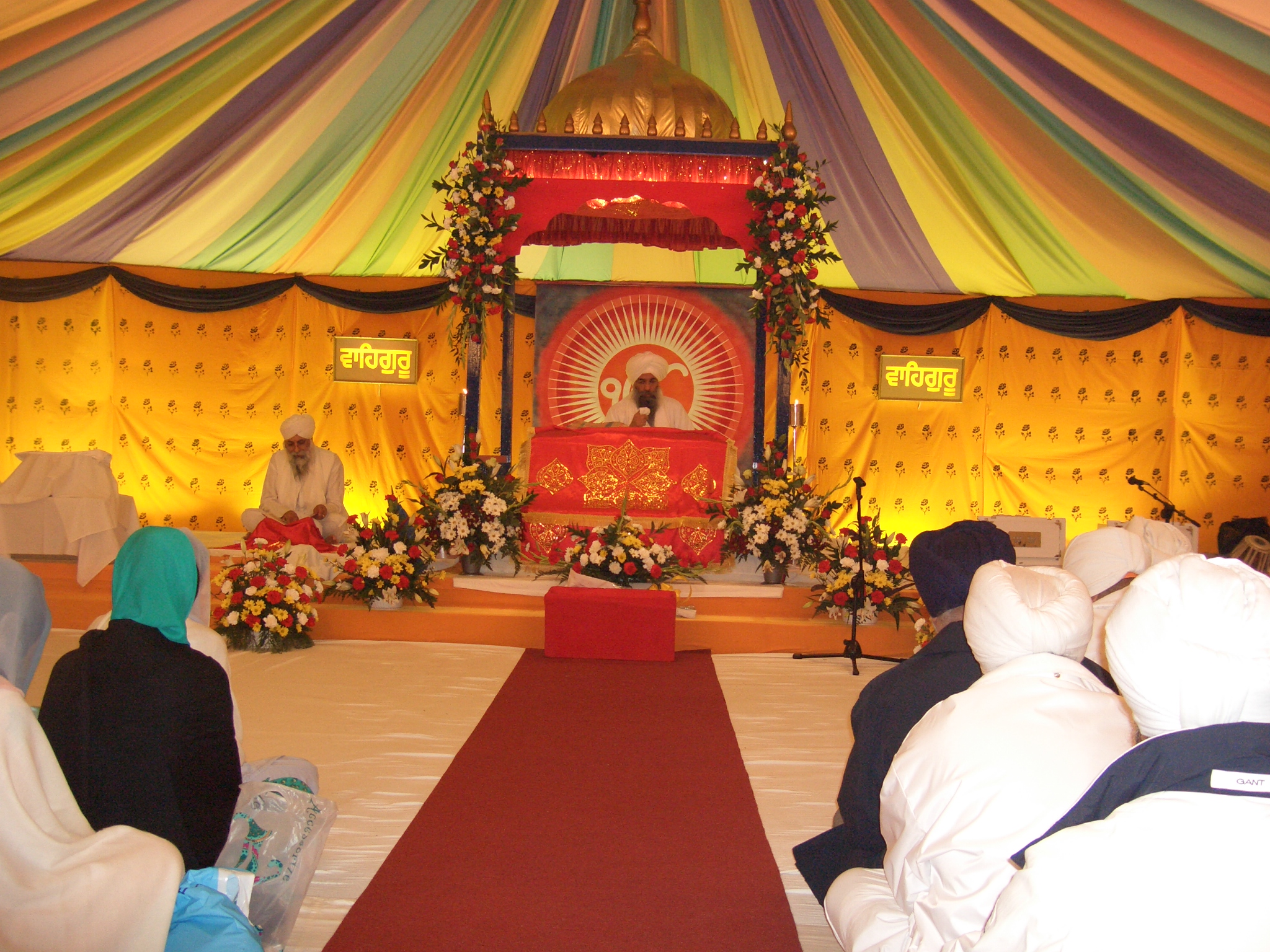
All visitors to a Sikh Gurdwara should be aware of the following guidelines when visiting:
- Please dress appropriately so that you can comfortably and with decency sit on the carpeted floor. It is recommended that all visitors to the Gurdwara wear loose fitting clothing which covers most of your legs. Low hanging or tight-fitting pants/trousers may not be suitable. Please try sitting on the carpeted floor at home for a short period to see if the clothing is suitable.
- All visitors entering the Main Prayer Hall, called the Darbar Sahib and the Dining (Langar) Hall will have to remove their shoes and place them in the shoe racks provided.
- Strictly No Smoking is allowed in the vicinity of the Gurdwara premises. Visitors cannot enter the Gurdwara while under the influence of Alcohol or Drugs. You should not take cigarettes or tobacco with you into the premises or smoke while near the Gurdwara or soon before going into the Gurdwara.
- All visitors MUST cover their heads while in the main Gurdwara areas ie: (Darbar Sahib and Langar Hall) .....More
Contents: Top 200. 210. 220. 230. 240. 250. 260. 270. 280. 290.
254
Kirtan Sohila: This is the night time prayer said by all Sikhs before they go to sleep.
Three Sikh Gurus – Guru Nanak, Guru Ram Das and Guru Arjan - contributed five shabads in total to this bani on the pain of separation and celebrating the bliss of union.
The first three shabads were uttered by Guru Nanak and the fourth by Guru Ram Das and fifth by Guru Arjan Dev. It is the most harmonious Naad ever uttered. It multiplies the aura to the sensitivity of protection that it eliminates any negativity for miles and miles.
When you are endangered by any species of direct or indirect source; when you want to protect yourself with the surrounding of the entire magnetic field of the earth, recite Kirtan Sohila. It is a cure for Insomnia! The religious and artistic value of these hymns is superb.
Contents: Top 200. 210. 220. 230. 240. 250. 260. 270. 280. 290.
255
Giani Sant Singh Maskeen (1934-18 February 2005) was born in 1934 at a place called Lak Marwat in District Bannu in present Pakistan.
Giani ji was the only son of his parents and had lived at Alwar in Rajasthan for the last 57 years of his life.
He was honoured by the Sikh community with the rare title of “Panth Rattan” for his services to mankind through the message of Gurbani. Sadly “Panth Rattan” Giani Sant Singh Maskeen passed away on 18th February 2005 at approximately 8.00 AM I.S.T. due to a massive heart attack while attending a marriage function in Etawah in Uttar Pradesh, India.
It is beyond doubt that Giani Sant Singh Maskeen was the most venerated and best known religious scholar among the Sikhs. This was due to the fact that he had in-depth and a broad knowledge of Gurmat and Gurbani; deep knowledge and understanding of comparative religions; and was armed with an excellent art of delivery of this vast knowledge database. .....More
Contents: Top 200. 210. 220. 230. 240. 250. 260. 270. 280. 290.
256
The early years of the 19th century witnessed the power of the Durrani declining.
Maharaja Ranjit Singh was encroaching the Afghan Kingdom and the Maharaja was eager to avail himself of any opportunity to snatch the rich province from the Durranis, the rulers of Afghanistan.
An opportunity came to Maharaja Ranjit Singh, when he annexed Attock in 1813 from the Afghans. But his initial attempts of 1814 and 1815 to seize Kashmir failed miserably. But then another opportunity arrived in 1819 when a Kashmiri Pandit, Birbal Dhar, a revenue collector of the Valley under the Afghans, escaped first to Jammu and then to Lahore and urged the Sikh ruler to free the Kashmiris from the Afghan’s oppression.
Sikh forces under the command of Missar Diwan Chand and properly guided by Birbal Dhar and Mian Gulab Singh invaded the Valley in 1819 A.D. Jabbar Khan the acting Governor of Kashmir collected his troops and faced the Sikh army but he failed to stop the onslaught of the Sikh forces. .....More
Contents: Top 200. 210. 220. 230. 240. 250. 260. 270. 280. 290.
257
Guru Amar Das (Gurmukhi: ਗੁਰੂ ਅਮਰ ਦਾਸ) (Sunday 23 May 1479 - Thursday 16 September 1574) was the third of the Ten Gurus of Sikhism and became Guru on 16 April 1552 at the age of 73 following in the footsteps of Sri Guru Angad Dev Sahib Ji, who left for his heavenly abode on 29 March 1552 aged 48. Guru Amar Das ji was 73 years old when he became the Sikh Guru.
Guru Ji was the eldest son of Sri Tej Bhan Ji a farmer and trader and Mata Lachmi Ji, his devoted mother. He was a shopkeeper and lived in a village called Basarke which is near Amritsar. The third Sikh Guru was married to Mata Mansa Devi and they had four children - Two sons named Bhai Mohan and Bhai Mohri and two daughters named Bibi Dani Ji and younger daughter named Bibi Bhani Ji. Bibi Bhani later married Bhai Jetha who became the fourth Sikh Guru, Guru Ram Das. See article Platforms of Jetha.
The Third Sikh Guru contributed the following to the people of the world:
- Guru sahib instigated the system of "First Pangat then Sangat"
- Further abolished the Caste System. .....More
Contents: Top 200. 210. 220. 230. 240. 250. 260. 270. 280. 290.
258
Conquest of Sadhora or Sadhaura was a conquest in 1709 by Banda Singh Bahadur of the area around Sadhaura. He fought with Nawab Usman Khan who had tortured and killed Pir Buddhu Shah.
Peer Buddhu Shah (13 June 1647 - 21 March 1704), a Muslim divine whose real name was Badr ud Din, was not only an admirer but also a staunch ally of Guru Gobind Singh.
During the Battle of Bhangani, Pir Budhu Shah came to the Guru's aid with his seven hundred followers, four sons and two brothers. The Guru had witnessed his dedication and support for the Sikh cause.
Banda Singh Bahadur avenged the Pir's execution in 1709 by storming Sadhaura and killing 'Usman Khan. Ancestral house of Pir Buddhu Shah in Sadhaura was converted into a Gurdwara named after Pir Buddhu Shah. Sikhs of Labana community belonging to nearby Ladhora village played an important role in this conquest.
A strange thing happened when the Muslim conquerors reached India. .....More
Contents: Top 200. 210. 220. 230. 240. 250. 260. 270. 280. 290.
259
Gurdwara Baba Jaani Shah is a holy Sikhs shrine (Gurdwara) situated in the township of Sri Hargobindpur in Gurdaspur District, along with Gurdwara Damdama Sahib.
It is a small square shaped building which contained the Mazhar Of Baba Jaani Shah. Now within this building the parkash of Guru Granth Sahib is done here as well.
Baba Jaani Shah was devotee of sixth Guru, Guru Har Gobind who was in the search of God but could not find Him anywhere; although he had looked far and wide. Then guided by Khwaza (Guru's servant), Babaji met Guru Hargobind and got much joy and internal satisfaction, relief and eventually salvation.
The history (sakhi) relating to Gurdwara Baba Jaani Shah is recorded as follows:
One day, Sayyed Jaani Shah a Muslim devotee got a great urge and intense longing to find and connect with God. He left his family in the hope of finding a path to God. He disguised himself as a faqir (religious man) and set off on his trip to find eternal peace. .....More
Contents: Top 200. 210. 220. 230. 240. 250. 260. 270. 280. 290.
260
Jassa Singh Ramgarhia (1723 - 1803) was a prominent Sikh leader during the period of the Sikh Confederacy.
He became the Misldar (Chief/Leader) of the Ramgarhia Army (misl). This period was an interlude, lasting roughly from the time of the death of Banda Singh Bahadur in 1716 to the founding of the Sikh Empire in 1801. The period is also sometimes described as the Age of the Misls.
Jassa Singh Ramgarhia is not to be confused with Jassa Singh Ahluwalia; both were prominent Misldars of separate powerful Sikh army groups, called Misls. Ramgarhia's father was called Giani Bhagwan Singh.
Ramgarhia was born Jassa Singh Thoka at Ichogil village in 1723, near the city of Amritsar into a Tarkhan family of the Sehmi Clan.
His grandfather, Baba Hardas Singh was a resident of Sur Singh, a large village in the Lahore district. He took Pahul (the Sikh baptismal oath/Amrit) from the hands of Guru Gobind Singh, the initiator of the Pahul tradition who bestowed the original Panj Piares. .....More
Contents: Top 200. 210. 220. 230. 240. 250. 260. 270. 280. 290.
261
Mata Kaulan was a women who was a free spirit and wanted to explore her surroundings. She had been adopted by a Muslim priest called Rustam Khan. He was based in Lahore, located in present-day Pakistan.
Qazi Rustam Khan had bought her from her parents while she was a child. It is possible that her parents were Hindus. The Qazi gave her the education of Islam and sent her to Saint Mian Mir for higher schooling.
Saint Mian Mir was a Sufi saint. He had no prejudice against any religion. He had a very deep love with Guru Nanak's Institution. It was usual for him to go to Amritsar to meet the Guru Arjan Dev ji.
Whenever the Guru visited Lahore, he never went back without seeing Saint Mian Mir. Due to these meetings, Saint Mian Mir knew a large number of Guru's verses by heart which he used to quote to his disciples.
Bibi Kaulan also remembered some of the verses by heart which she used to recite herself as she found them very touching and allowed her to relate to God. .....More
Contents: Top 200. 210. 220. 230. 240. 250. 260. 270. 280. 290.
262
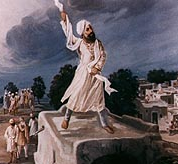
Makhan Shah Labana (Punjabi: ਮੱਖਣ ਸ਼ਾਹ ਲਬਾਣਾ), was born on 7 July, 1619. He was a devout Sikh and a rich trader from Tanda district, Jhelum (now in Pakistan). He is called "The discoverer of the ninth Nanak" for his famous act of finding the ninth Sikh Guru, Guru Tegh Bahadur in Bakala, India in around 1665. The Sakhi (true story) of that discovery was recorded in "Janamsakhis" and has been told as a story among the Sikhs for many generations.
Baba Makhan Shah was born to Mata Vijey Devi. His father was named Bhai Dasa. He was born on 23 Ashad 1676 Bikarami, which translates to 7th July, 1619. Macallife, Teja Singh, Ganda Singh and Colonel Gurcharan Singh support this date; however the historical record of Makhan Shah is not complete.
He got his basic education from Vijaynagar. He was a master in Sanskrit language and also learned many foreign languages including Portuguese and English, which were picked up during his sea travels as a trader. He was not a good speaker of Punjabi; Lubanki was his mother tongue and that is why when he found Guru Tegh Bahadur he shouted GURU LADHO RAE (which means "Found the Guru" in Lubanki.) .....More
Contents: Top 200. 210. 220. 230. 240. 250. 260. 270. 280. 290.
263
Sikh Gurdwaras Act, 1925 was a piece of legislation passed by the Punjab Legislative Council on 9 July 1925.
It marked the culmination of the struggle of the Sikh people from 1920-1925 to wrest control of their places of worship from the mahants or priests.
The Gurdwaras had passed into their hands during the eighteenth-century when the Khalsa were driven from their homes to seek safety in remote hills and deserts.
When they later established their sway in Punjab, the Sikhs rebuilt their shrines endowing them with large jagirs and estates. The management, however, remained with the priests, belonging mainly to the Udasi sect, who, after the advent of the British in 1849, began to consider the shrines and lands attached to them as their own personal properties and to appropriating the income accruing from them to their private use.
Some of them alienated or sold gurdwara properties at will. They had introduced ceremonies which were distasteful to orthodox Sikhs. Besides, there were complaints of immorality against them. All these factors gave rise to what is known as the Gurdwara Reform movement during which Sikhs had to court jail on a large scale and suffer atrocity and death to get control of key Sikh shrines. .....More
Contents: Top 200. 210. 220. 230. 240. 250. 260. 270. 280. 290.
264
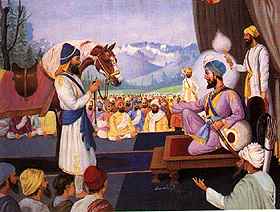
Once when Guru Arjan's wife, Mata Ganga ji was serving Langar to Bhai Buddha ji, he said,
"As you have given me food to my heart's content, so shall you have a son to your heart's content. He shall be very handsome and brave and shall possess power on earth and in heaven. He shall wear two swords and be mighty in battle. He shall sit on a great imperial throne. He shall be both a great warrior and an exalted Guru."
In time, a beautiful son was born to Guru Arjan and Mata Ganga and he was named Hargobind. His childhood was full of trials because his uncle Prithia wanted his own son, Mihrban, to be the next Guru. He survived these trials and at the proper age received his education from Bhai Buddha and Bhai Gurdas.
They instructed Hargobind in the Guru's shabads (hymns), the sciences, reading and letters, offensive and defensive weapons, sports such as swimming and gatka, administration and many other skills that he would need to be a great spiritual ruler in the future. He grew up in the court of Guru Arjan and watched his father compile the Guru Granth. .....More
Contents: Top 200. 210. 220. 230. 240. 250. 260. 270. 280. 290.
265
In the time of Sri Guru Hargobind Sahib Ji during the 1600's, there was a poor Gursikh who lived alone in a tiny, little mud hut on the outskirt of a small village. This Gursikh was blind and had a lot of Pyaar (love) for the Guru. He had heard about the powerful Guru who was the protector of the meek and poor.
As he couldn't travel anywhere he would ask people to go to see Guru ji and then wait for their return to hear about the Guru. He would ask them - What does my Guru Ji look like? How brave is he? What weapons does he keep? What stories does he tell, etc and each would reply "The Guru's description is beyond speech. He is too handsome and far too powerful to be described verbally by mere words - I don't have the words to explain all his marvellous virtues."
One night he could not sleep; he kept thinking of Guru ji and how wonderful he was. He longed so much to see the beautiful Mukh (appearance) of Guru Maharaj. The pain of the longing got too intense; he could not take it any longer. The separation was becoming unbearable. He felt angry at himself and began to blame himself for his predicament. .....More
Contents: Top 200. 210. 220. 230. 240. 250. 260. 270. 280. 290.
266
On July 11 1675, the ninth Sikh Guru, Guru Tegh Bahadur sets off from Anandpur sahib for Delhi in what was to become a world first; the sacrifice of his life for the religious rights and freedoms of the Kashmiri Pandits.
This was to be the first step and the beginning of an extremely important event in Sikh history. It was to have a profound impact on the future direction of Sikhism, the religion of the Sikhs.
Guru Tegh Bahadur undertook the supreme sacrifice for the protection of the most fundamental of human rights - the right of a person to freely practice his or her religion without interference or hindrance. In modern times, we tend to take this freedom for granted – but in 1675, millions of people were denied this basic right.
However, what is even more astonishing is the fact that the Guru was not protecting the right of the Sikhs to practise their religion but instead the rights of the non-Sikh peace-loving people from Kashmir. .....More
Contents: Top 200. 210. 220. 230. 240. 250. 260. 270. 280. 290.
267
It is well known that alcohol is a drug. It has an almost immediate effect on the brain and will alter ones mood. Drinking alcohol makes people feel relaxed, happy and even euphoric, but in reality alcohol is a depressant.
Depressants are psychoactive drugs which temporarily diminish the function or activity of a specific part of the body or mind. Alcohol switches off the part of the brain that controls judgement, leading to loss of inhibitions.
Drinking even small amounts of alcohol can affect physical coordination and stability. Prolonged and heavy alcohol use poses serious health risks. Alcohol is one of the major causes of liver cirrhosis (irreversible scarring of the liver).
This happens because healthy liver cells die and the dead cells are replaced by fibrous tissue.
Some of the other risks of alcohol are:
|
|
The Guru Granth Sahib forbids drinking alcohol. The Guru says:
- "Drinking wine, his intelligence departs, and madness enters his mind;"
- "He cannot distinguish between his own and others,"
- "He is struck down by his Lord and Master" (SGGS p554)
Contents: Top 200. 210. 220. 230. 240. 250. 260. 270. 280. 290.
268
Degh Tegh (Punjabi ਦੇਗ ਤੇਗ) or Degh Tegh Fateh: This term forms part of the Sikh Ardas where it is recited in the line: "ਦੇਗ ਤੇਗ ਫਤਹ, ਬਿਰਦ ਕੀ ਪੈਜ, ਪੰਥ ਕੀ ਜੀਤ...." "Daeg taeg fateh, bihrd kee paaej, Panth kee jeet....".
The first phrase is "Daeg taeg fateh" which means victory to "degh and tegh"; the second phrase is "bihrd kee paaej" or "protecting the honour or respect of the old or elderly" "and the third phrase is "Panth kee jeet" or "victory to the panth or 'followers of the righteous path'". In this article, we will just look at the first phrase: "Daeg taeg fateh". The word "fateh" in Punjabi means "victory" or "victorious".
The word "degh" means "large cooking pot" or "cauldron" or an "offering". The word "tegh" means "sword" or "kirpan". The term "degh tegh" refers to the concept of "degh" which is the serving of food to the community as in respect of the Langar; and "tegh" which is the protecting the liberty and rights of each member within the community.
The two concepts of making sure that everyone in the community is fed and does not go hungry; and also that no one's life in the community is in any danger and that all in society feel safe and protected are both concepts equally promoted by Sikhi and the Sikh Gurus. .....More
Contents: Top 200. 210. 220. 230. 240. 250. 260. 270. 280. 290.
269
Bhai Taru Singh (c. 1720 - 16 July, 1745), a Sikh martyr who was a Sandhu Jatt of Puhia village, now in Amritsar district of the Punjab.
He was a pious Sikh who following the teachings of the Sikh Gurus; worked hard tilling his land diligently and lived frugally; although not a rich man, he was always happy and did much for his Sikh brothers and sisters.
Whatever he saved went to his Sikh brethren forced into exile by government persecution. He was spied upon by Akil Das (also known as Harbhagat Niranjania) of Jandiala, a government informer and subsequently, Taru Singh was hauled before Zakariya Khan, the governor of Punjab who was based at Lahore.
Born in Punjab during the reign of the Mughal Empire, Bhai Taru Singh was raised as a Sikh by his widowed mother. During this time, Sikh revolutionaries were plotting the overthrow of the Khan and had taken refuge in the jungle. Bhai Taru Singh and his sister gave food and other aid to these Sikh fighters.
Akil Das, having informed Zakaria Khan and the government authorities about both Bhai Taru Singh and his sister, the two were arrested for treason. .....More
Contents: Top 200. 210. 220. 230. 240. 250. 260. 270. 280. 290.
270
Baba Atal Rai (c. 1619 - 23 July, 1627) was born in 1619 AD at Amritsar to Guru Hargobind sahib, the sixth Sikh Guru and Mata Mahadevi, daughter of Bhai Daya Ram Marwah of Mandeala.
From early age he was intelligent, lively and a deeply religious boy. He was called 'Baba' because he carried a wise head over his young shoulders. (Here Baba means, wise old man).
He used to play every evening with his age-mates and tell them many wise things. Whatever he said, even in jest, had some deep humane meaning. All his playmates loved, respected and obeyed him. Guru Hargobind was specially fond of him.
The Guru used to take him in his lap, cuddle him and say, “God has given you much power. Don’t make a show of it. If you have to use it, use it with caution and wisdom. Don’t waste it away on little things”. Baba Atal Rai used to say in reply, “O True King, all the power that I possess I have obtained from you. Your storehouse can never be empty. Therefore, I may use it to my heart’s content. It will never be used up.”
Bibi Kaulan, the daughter of Lahore’s Qazi had been a dedicated devotee of Guru Hargobind sahib. Kaulsar Sarovar (Pool) was built by Guru Hargobind sahib in her memory. .....More
Contents: Top 200. 210. 220. 230. 240. 250. 260. 270. 280. 290.
271
Teja Singh Samundri (20 February, 1882 - 17 July, 1926), a leading figure in the Gurdwara Reform Movement and a founder member of the Shiromani Gurdwara Parbandhak Committee, was born the son of Deva Singh and Nand Kaur at Rai ka Burj in Tarn Taran tahsil in Amritsar district, on 20 February, 1882.
On land being assigned to his father, Deva Singh in the Sandal Bar tract of tahsil Samundri of Lyallpur district, Punjab (now in Pakistan), he moved with his family to this newly developed colony.
Teja Singh's formal education did not go beyond the primary stage, but he was well equipped in the Sikh religious and historical texts. Following in his father's footsteps, he joined the army as a "Dafadar" in 22 Cavalry. But his army career lasted only three and a half years. He returned to his village which was then called, Chak 140 GB, to devote himself to the promotion of religious and social reform in the panth.
He became a member of the Chief Khalsa Diwan and helped to establish the Khalsa Diwan Samundri. Later this and other similar societies working in that area were through his initiative knit into a bigger organization called the Khalsa Diwan Bar. .....More
Contents: Top 200. 210. 220. 230. 240. 250. 260. 270. 280. 290.
272
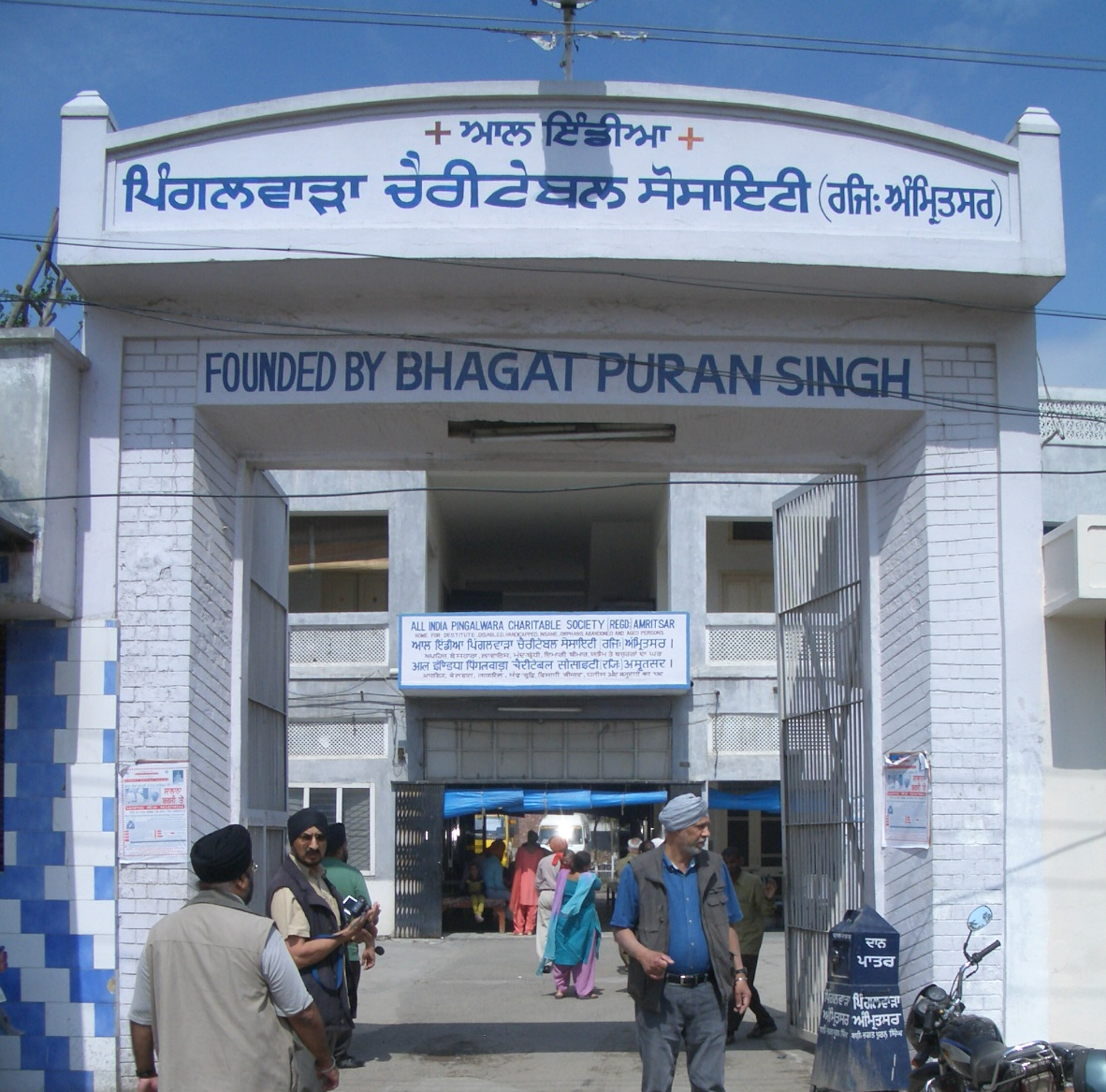
Pingalwara was the name given to a humble house for the destitute in Amritsar in northern Indian state of Punjab.
Sikhism promotes a duty of care for the weak in society; this institute is a result of the vision of one person derived from the words of the Sikh Gurus on this issue.
In the early 1900's, it was an original idea of the founder, Bhagat Puran Singh to catered for the people who had been rejected by society.
It was initially an ad-hoc facility for the disabled; the mentally ill; the dispossessed; generally for people who were no longer accepted by anyone in society.
Bhagat Puran Singh built this institute literally single-handed with the ideals of his mother as his driving force; the message of Gurbani as a beckon and the generosity of the Punjabi society as his safety net and hunting ground. He begged; worked as hard as he physically and mentally could; resorted to whatever options were available to care and provide for his "patients" just like a father or mother would care and provide for his children.
No barrier or hurdle could stop him in his effort to care for these "community rejects". He left no stone unturned to bring some dignity to the lives of individuals who had no one in this world except this saint. .....More
Contents: Top 200. 210. 220. 230. 240. 250. 260. 270. 280. 290.
273
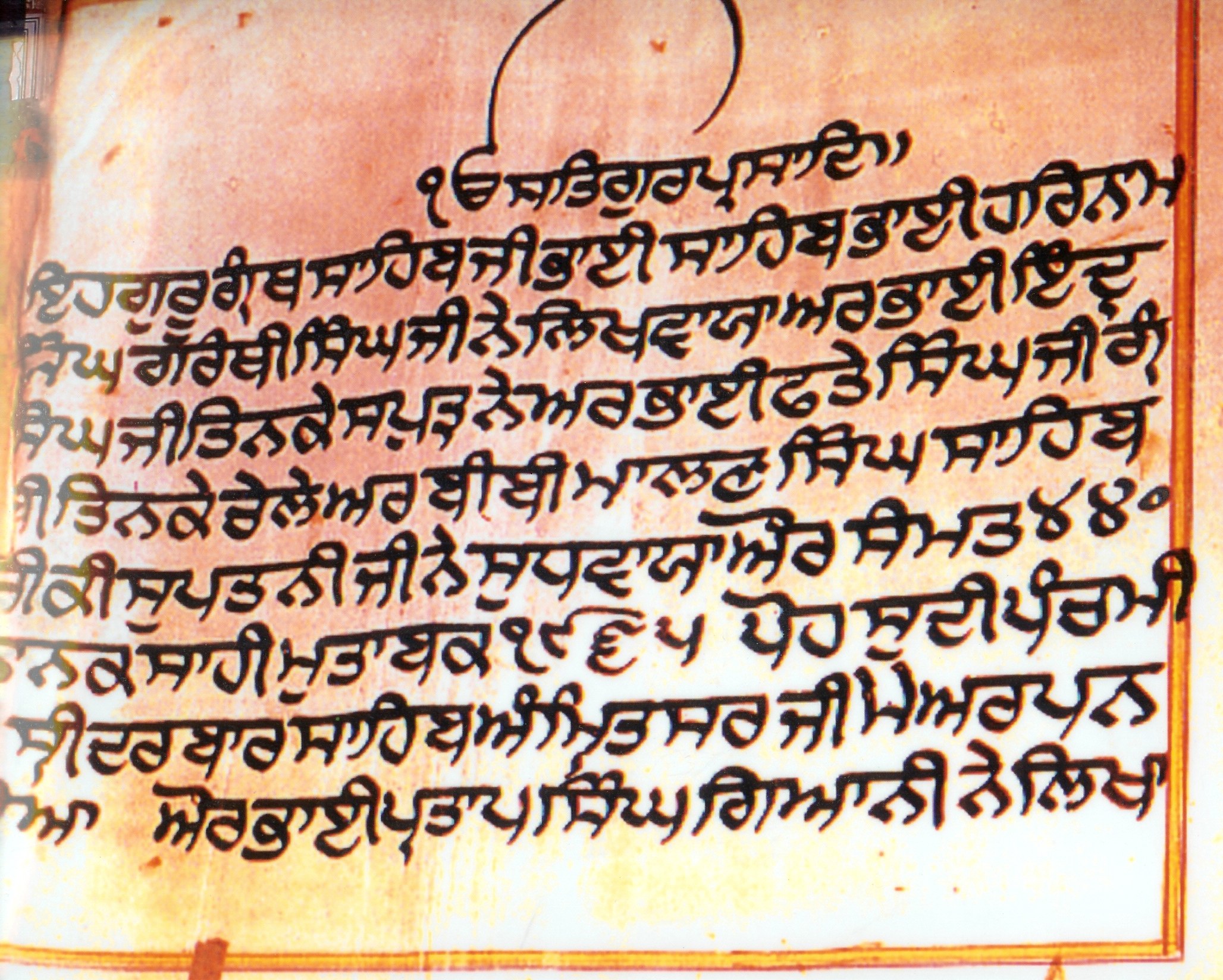
The editorial pattern of Guru Granth Sahib is the gift of the illustrious Guru Arjun Dev. The current volume of the Granth (total pages 1430) follows in the main the editorial scheme set by the Fifth Guru, with addition of Guru Tegh Bahadur’s Bani-compositions including his verses in Raag Jaijavanti.
The first recension popularly known as the Adi-Granth comprised three broad divisions: (a) the liturgical section with prayers of daily routine; (b) the musical section that is by far the largest part (1340 pages of the present edition); (c) the miscellaneous part of compositions which are not set to Raag measures but dwell on various poetical metres.
The contributors of the Granth include six Gurus, 15 Bhagats, 12 Bards (Bhatts) plus one Dum, a couple of associates of the Gurus, making a total of 36 authors.
The verses composed by eleven Bhatts in the Swayya metre are to be found in the Miscellaneous division of the holy Granth, which starts with Sahaskriti Saloks, followed by Gatha, Phunhas, Chaubolas and Saloks of Bhagat Kabir and Shiekh Farid. .....More
Contents: Top 200. 210. 220. 230. 240. 250. 260. 270. 280. 290.
274
The Battle of Hargobindpur was, the second battle in which Guru Hargobind and his Sikh Risaldari (comrades), fought the forces of Abdullah Khan the Mughal governor, (Subedar) of Jalandhar.
This historic war happened in September 1629 (according to some chronicles 1628).
The battle was fought near the village of Ruhela where Guru Hargobind and his warriors defeated the Mughal force commanded by Turkish chieftains and the governor Abdullah Khan.
After the victory the area in which the battle was fought became the town of Sri Hargobindpur.
Much earlier a new village called Hargobindpur had been established near the village of Ruhela, on the bank of the Beas river by Guru Arjan Dev.
The fifth Guru named this new village in honour of his young son Hargobind. However, after the arrest, torture and martyrdom of Guru Arjun Dev, the area fell under the control of Diwan Chandu Lal, an influential Hindu banker and chief minister of Emperor Jahangir. .....More
Contents: Top 200. 210. 220. 230. 240. 250. 260. 270. 280. 290.
275
Gurdwara Patti Sahib also called Gurdwara Maulvi Patti Sahib (‘Patti’ (Gurmukhi: ਪਟੀ) is a Gurmukhi word meaning ‘alphabet’) is built at the site where Guru Nanak at a young age learned the various different languages then used in the Punjab, each with its own distinct alphabet.
This shrine lies midway between Gurdwara Janam Asthan and Gurdwara Bal Lilah along the road leading from Janam Asthan to the railway station in Nankana Sahib. The city has been renamed after its most famous native son Guru Nanak Dev ji. Once known as the village of Talwandi the town is located in West Punjab, Pakistan.
Born on the 15th of April 1469. Nanak was named after his elder sister Nanaki who was named so because of her being born at the house of her "Nana" (maternal granddad or grandfather on mother's side) in the village of Dera Chahal in Lahore district.
As a young child Guru Nanak first studied Punjabi with Pandit Gopal, then Sanskrit with Pandit Brij Lal and at 13 years of age he mastered Persian studying with Maulvi Kutab Ud Din. Hence Patti Sahib is also known as Gurdwara Maulvi Patti Sahib. .....More
Contents: Top 200. 210. 220. 230. 240. 250. 260. 270. 280. 290.
276
Gurdwara Mal ji sahib is in Nankana Sahib, Pakistan and near the local railway station but closer to this famous town associated with the founder of Sikhi, Guru Nanak. Mal (also called jal and van) is a shady tree.
It is said that once as Rai Bular was riding among the fields in this area, he saw young Nanak sleeping in the shade of a mal tree.
What struck Rai Bular was that the shade of the tree had not moved away from the sleeper as the movement and position of the sun warranted.
According to another version, the shade had moved away from the Guru but a large cobra had spread its huge hood over his face so that his sleep was not interrupted. This miracle and the incident related to Kiara Sahib convinced Rai Bular of the spiritual eminence of Guru Nanak Dev whose devotee he became.
This Gurudwara, too, was first built by Diwan Kaura Mal and renovated by Maharaja Ranjit Singh. It is larger and more imposing than Kiara Sahib with its broad copings mounted with domelets around the central dome, domed kiosks at the corners of the roof and porches on the sides of the hall. .....More
Contents: Top 200. 210. 220. 230. 240. 250. 260. 270. 280. 290.
277
Gurdwara Chakki Sahib, at Eminabad is located where a large millstone was kept which was once used by Guru Nanak. In the Janamsakhis, it is mentioned that Guru Nanak Dev was taken as a prisoner along with thousands of his fellow countrymen by Babar's men.
Baba ji was, along with many of his fellow prisoners, forced to grind corn with hand-driven chakkis (millstones). His captors were surprised to see that the millstone used by Guru Nanak was turning, by itself, while Baba ji was simply pouring grist into the opening in the stone as he sang songs to the Glory of One God.
The Guru's songs to 'One God' (the Mughals as Muslims also believed in One God) and, even more the stone's turning by itself amazed the Mughal soldiers who brought this to the immediate attention of Babar. .....More
Contents: Top 200. 210. 220. 230. 240. 250. 260. 270. 280. 290.
278
Bhai Mani Singh "Shaheed" (martyr) (1670 - 9 July 1737), was a great Sikh personality of the eighteenth century; he occupies a very esteemed position in Sikh history as he assumed control and steered the course of destiny of the Sikh panth at a very critical stage.
A great scholar, a devoted Sikh, and a courageous leader, Bhai Mani Singh willingly laid down his life to uphold the dignity of the Sikh faith and Sikh principles. Due to the nature of his martyrdom, his actions have become a part of the daily Sikh Ardas (prayer) of the Sikhs.
He is said to have been brought in the early years of his childhood to the presence of Guru Tegh Bahadur at Anandpur. He was not the same age as the Guru's own son, Gobind Rai; however they became close friends.
Bhai Mani Singh remained in his company even after he had ascended the religious seat as Guru in 1675. Mani Singh accompanied the Guru to the seclusion of Paonta sahib where Guru Gobind Singh spent some three years in large part given to literary work. .....More
Contents: Top 200. 210. 220. 230. 240. 250. 260. 270. 280. 290.
279
Harbhajan Singh Khalsa Yogiji (born as Harbhajan Singh Puri)[1] (August 26, 1929 - October 6, 2004), also known as Yogi Bhajan and Siri Singh Sahib, was a charismatic and influential proponent of Kundalini Yoga and Sikh Dharma. He is best known as the spiritual director of the 3HO (Healthy, Happy, Holy Organization) Foundation, which today is one of the world's largest yoga-teaching bodies, and for his outspoken defense of the holistic doctrine of Sikh teachings. He was widely known as a master of Kundalini Yoga and taught thousands to be teachers and spread the teachings.
Harbhajan Singh was born on August 26, 1929 into a Sikh family in Kot Harkarn, district Gujranwala, in the province of Punjab (British India). His father, Dr. Kartar Singh Puri, served the British Raj as a medical doctor. His mother was named Harkrishan Kaur. Theirs was a well-to-do landlord family, owning most of their village in the foothills of the Himalayas. .....More
Contents: Top 200. 210. 220. 230. 240. 250. 260. 270. 280. 290.
280
Guru Gobind Singh in the Dasam Granth in verse number 9 of Tav Prasad Saviaye puts a seal on the concept of Love leading to salvation.
Tav Prasad Saviaye is one of the five Banis of a Sikh's daily Nitnem routine of reciting of the Guru's words.
In this Bani (Guru's composition), the tenth master covers many aspects of human living which one needs to inspect on a daily basic but the central message is the concept of "Love for the Lord and his creation" and the "constant remembrance of His Name".
If you do not feel any love for God; you will not feel any love for His creation and vice versa; your heart will be barren and you will have no compassion or mercy. The Guru reminds us:
| ਸਾਚੁ ਕਹੋਂ ਸੁਨ ਲੇਹੁ ਸਭੈ ਜਿਨ ਪ੍ਰੇਮ ਕੀਓ ਤਿਨ ਹੀ ਪ੍ਰਭ ਪਾਇਓ ॥੯॥ |
| Sach kahon sun leho sabai jin prem kio tin hee prabh paio. |
| I tell the truth; listen everyone. Only those who have Loved, will realize the Lord. (9) |
The message of Love and longing is evident on all the pages of the Sikh scriptures. The Love for God and His creation is easy to see in Gurbani; the Lord is referred to as "Husband Lord", "Beloved", "Immaculate", "Great", "Merciful", etc. all affectionate words for a tender, caring and powerful being. .....More
Contents: Top 200. 210. 220. 230. 240. 250. 260. 270. 280. 290.
281
Gurdwara Janam Asthaan is the shrine representing the home of Mehta Kalyan Dass and Mata Tripta, the father and mother respectively of Guru Nanak Dev, founder of Sikhism.
This is the location of the home where the founder Guru was born; the original shrine was established by Baba Dharam Chand (1523-1618) son of Baba Lakhmi Das and grandson of Guru Nanak Dev.
The shrine is located in the holy city of Nankana Sahib, West Punjab, Pakistan.
The shrine must have been established before the end of the sixteenth century because Guru Arjan Dev (1563-1606) is believed to have visited it. Its present building comprising a square, domed sanctum with a rectangular pavilion attached to it within a vast walled compound was built by Maharaja Ranjit Singh.
It is believed that a room was first built here by the Guru's son, Baba Lakhmi Das (1497-1555) but it is more probably that this was built by his grandson, Baba Dharam Chand (1523-1618). The initial building was known as "Kalu ka Kotha", literally meaning the "house of (Mehta) Kalu", father of Guru Nanak. Later it came to be known as "Nanakayan", literally "home of (Guru) Nanak". .....More
Contents: Top 200. 210. 220. 230. 240. 250. 260. 270. 280. 290.
282
Lord Krishna is a deity worshipped across many traditions in Hinduism in a variety of perspectives. While many Vaishnava groups recognize him as an avatar of Vishnu, other traditions within Krishnism consider Krishna to be 'svayam bhagavan', or the Supreme Being.
The tenth Sikh Guru, Guru Gobind Singh in the Dasam Granth has written a section of Bani called Chobis avatar. This is the seventh Bani in the second holy scriptures of the Sikhs.
This is a collection of tales of the twenty-four incarnations of the demi-god Vishnu, and forms a part of Bachitra Natak. The complete work contains a total of 4,371 verse units of which 3,356 are accounted for by "Ram avtar" and "Krishn avtar". The shortest is Baudh Avatar (The Buddha) comprising three quatrains, and the longest is Krishn avtar, with 2,492 verse units, mostly quatrains.
In Hindu literature, Krishna is often depicted as an infant, as a young boy playing a flute as in the Bhagavata Purana, or as a youthful prince giving direction and guidance as in the Bhagavad Gita. .....More
Contents: Top 200. 210. 220. 230. 240. 250. 260. 270. 280. 290.
283
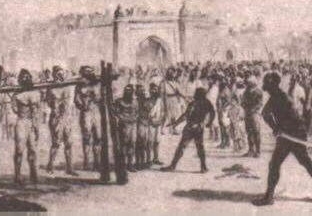
Zakariya Khan (d. 1 July 1745) was the Mughal governor of Lahore from 1726 onwards when he replaced his father 'Abd us-Samad Khan' as governor of this famous historic city and province now located in Pakistan.
He had earlier acted as the governor of Jammu from 1713 to 1720 and of Kashmir from 1720 to 1726. He had also taken part in Lahore government's operations against the Sikh leader Banda Singh Bahadur.
After the capture of Banda Singh and his companions in December 1715 at Gurdas Nangal, he escorted the prisoners to Delhi, rounding up Sikhs that he could find in villages along the route. As he reached the Mughal capital, the caravan comprised seven hundred bullock carts full of severed heads and over seven hundred captives.
After becoming the governor of the province in 1726, Khan Bahadur Zakariya Khan, shortened to "Khanu" by Sikhs, launched a still severer policy against the Sikhs and let loose terror upon them. His moving military columns forced the Sikhs to seek shelter in remote hills and forests. .....More
Contents: Top 200. 210. 220. 230. 240. 250. 260. 270. 280. 290.
284
MAI BHAGO, (Mata Bhag Kaur) the sole survivor of the battle of Khidrana, i.e. Battle of Muktsar (29 December 1705), was a descendant of Pero Shah, the younger brother of Bhai Langah, a Dhillon Jatt who had become a Sikh during the time of Sri Guru Arjan Dev Ji Maharaj. Born at her ancestral village of Jhabal in presentday Amritsar district of the Punjab, she was married to Nidhan Singh Varaich of Patti. A staunch Sikh by birth and upbringing, she was distressed to hear in 1705 that some of the Sikhs of her neighbourhood who had gone to Anandpur to fight for Guru Gobind Singh Ji had deserted him under adverse conditions.
She rallied the deserters persuading them to meet the Guru and apologize to him. She set off along with them and some other Sikhs to seek out the Guru, then travelling across the Malva region. Mat Bhago and the men she was leading stopped near the dhab or pool of Khidrana where an imperial army in pursuit of Guru Gobind Singh Ji had almost overtaken him. The 40 sikhs known as the "Chali Mukte" challenged the Mughal Imperial Army, which entered the battle with 10,000 soldiers, and inflicting such damage onto them, that they had no option but to retreat. Sri Guru Gobind Singh Ji, who had supported them with a shower of arrows from a nearby high ground, found all of the fourty men who had signed a paper dis-avowing him as their Guru, except one, Mahari Singh, had died of their wounds when he visited the battlefield. Mahari Singh, who had been seriously wounded, also died as the Guru took him into his lap. .....More
Contents: Top 200. 210. 220. 230. 240. 250. 260. 270. 280. 290.
285
Two self governing countries legally came into existence at the stroke of midnight on 15 August 1947. 14 August, 1947, saw the birth of the new Islamic Republic of Pakistan.
At midnight the next day, India won its freedom from colonial rule, ending nearly 350 years of British presence in India. The British left India divided in two. The two countries were founded on the basis of religion, with Pakistan as an Islamic state and India as a secular one.
India’s Independence Day is celebrated on August 15 to commemorate its independence from British rule and its birth as a sovereign nation on that day in 1947. The day is celebrated all over the country and by a growing diaspora around the world. Pakistan became independent on the previous day. What is sometimes forgotten is that the period signifies the single largest human migration of people in modern history.
Till today, there is no institutional memory of Partition: the state has not seen fit to construct any memorials, to mark any particular places – as has been done, say, in the case of Holocaust memorials, or memorials for the Vietnam War. .....More
Contents: Top 200. 210. 220. 230. 240. 250. 260. 270. 280. 290.
286
SOBHA SINGH (29 November 1901 - 21 August 1986) was a famous Sikh painter, especially well known for his portraits of the Sikh Gurus.
He was born on 29 November 1901 in a Ramgarhia family of Sri Hargobindpur, in Gurdaspur district of the Punjab. His father, Deva Singh, had been in the Indian cavalry.
In 1905, when he was only 4 years old, his mother Bibi Acchran died and some 12 years later, when he was about 16, his father S. Deva Singh died in 1917.
At the age of 15, Sobha Singh entered the Industrial School at Amritsar for a one year course in art and craft. It is said that in 1919 he was present in Jalianwala Bagh at the time of firing.
As a draughtsman in the Indian army he served in Baghdad, in Mesopotamia (now Iraq). On coming back from Baghdad, he married Inder Kaur. Whatever amount he had been sending to his sister from overseas, she had not saved anything out of it for him. They had a real hard beginning due to the stringency of money.
He left the army in 1923 to pursue an independent career in drawing and painting, initially in Amritsar at Bazar Mai Sewan. .....More
Contents: Top 200. 210. 220. 230. 240. 250. 260. 270. 280. 290.
287
Bhai Daya Singh (26 August 1669 - 1708), the first of the Panj Piare or the "Five Beloved" celebrated in the Sikh tradition.
He was the son of Bhai Suddha, a Sobti Khatri of Lahore, and Mai Diali. His original name was Daya Ram.
His name is uttered first among the five Beloved of the Guru (Panj Pyaras) in the Sikh Ardas.
Bhai Suddha was a devout Sikh of Guru Tegh Bahadur and had visited Anandpur more than once to seek his blessing. In 1677, he travelled to Anandpur along with his family including his young son, Daya Ram, to make obeisance to Guru Gobind Singh, this time to settle there permanently.
Daya Ram, already well versed in Punjabi and Persian, engaged himself in the study of classics and gurbani. He also received training in the use of weapons.
In the historic divan in the Keshgarh Fort at Anandpur on Vaisakhi 1699, he was the first to rise at the Guru's call and offer his head, followed by four others in succession. .....More
Contents: Top 200. 210. 220. 230. 240. 250. 260. 270. 280. 290.
288
Anandpur Sahib Resolution is a frequently invoked document of "modern Sikhism" pronouncing its religious aspirations as well as its political goal.
It was a resolution for the "self-determination" of the state of Punjab and was passed on 28 August 1973 at Anandpur Sahib. That resolution is now called the 'Anandpur Sahib Resolution'.
The Sikhs enjoyed political power under chief ministers, Gurnam Singh and Parkash Singh Badal in the Punjab which had been newly demarcated in 1966.
However, nationally the Sikhs represented by their premier political party, the Shiromani Akali Dal were only able to capture one seat at the elections to the Indian parliament in 1971 from among the 13 which were allocated to the whole of Punjab.
In the Punjab Assembly elections which took place in March 1972 their tally was a mere 24 seats out of a total of 117, and the Punjab Government passed into the hands of the Congress Party, with Giani Zail Singh (later, President of India) as chief minister. .....More
Contents: Top 200. 210. 220. 230. 240. 250. 260. 270. 280. 290.
289
Baba Buddha ji (6 October 1506 - 8 September 1631), one of the most venerated, primal figures of early Sikhism, was born on 6 October 1506 at the village of Katthu Nangal, 18 km northeast of Amritsar.
After sometime the family settled down in Dhalla village not far away from river Ravi opposite Kartarpur. "Bura", as he was originally named, was the only son of Bhai Suggha, a Jatt of Randhava clan, and Mai Gauran, born into a Sandhu family.
Bhai Budha occupies a unique position in Sikh history. He applied the tilak (forehead mark) of guruship to five Gurus, physically saw and had the vision of seven Sikh Gurus and remained in close association with the first six Sikh Gurus from 1521 to 1631 for over one hundred years. He was the first 'priest' (Giani) of Harimandir Sahib, and laid the foundations of Dera Baba Nanak and most of the holy buildings at Amritsar.
As a small boy, he was one day grazing cattle outside the village when, in 1521 A.D, Guru Nanak happened to pass by his village. .....More
Contents: Top 200. 210. 220. 230. 240. 250. 260. 270. 280. 290.
290
Sri Chand (9 September 1494 – 1629) was the eldest son of Guru Nanak, the founder of Sikhism.
Sri Chand was born to Mata Sulakhani on 9 September 1494 (Bhadon sudi 9, 1551Bk) at Sultanpur Lodhi, now in Kapurthala district of the Punjab. He had a reputation of saintliness, and was respected and liked by all.
Bibi Nanaki who was his aunt took in Sri Chand and adopted him as her own son. This type of arrangement was quite common and accepted custom at that time. Sri Chand became a renounced yogi.
After his father, Guru Nanak left Nankana Sahib, Sri Chand stayed in Dera Baba Nanak and maintained Guru Nanak's temple. Later he established the Udasi order, both he and his followers travelled far and wide to spread the Word of Nanak.
When Guru Ram Das met Baba Sri Chand, the Baba commented that Guru Ram Das had the longest beard he had seen. Guru Ram Das replied, "It is to wipe the feet of the saints". .....More
Contents: Top 200. 210. 220. 230. 240. 250. 260. 270. 280. 290.
291
Bhai Bachittar Singh (d. 1705), warrior and martyr, was the second son of Bhai Mani Ram, a Parmar Rajput and devotee of the Gurus.
One of the five brothers presented by their father for service to Guru Gobind Singh, he joined the order of the Khalsa on the historic Baisakhi day, 14 April 1699.
Subsequently, he shot into prominence during the first Battle of Anandpur against the hill chieftains, when, on 1 September 1700, he was selected by Guru Gobind Singh to single-handedly face a drunken elephant brought forth by the enemy to batter down the gate of Lohgarh Fort.
As the elephant approached the gate, Bachittar Singh, sallied forth on horseback and made a powerful thrust with his spear piercing the elephant's armour plate, injuring the animal in the forehead. The wounded elephant ran back creating havoc and great damage in the enemy's ranks. As a result of Bhai sahib's bold action, the Sikhs gained an upper hand in this conflict. .....More
Contents: Top 200. 210. 220. 230. 240. 250. 260. 270. 280. 290.
292
Baba Banda Singh Bahadur (16 October, 1670 - 9 June, 1716) (Lachhman Dev alias Madho dass Bairagi) , originally from the Jammu region, is revered as one of greatest Sikh warriors as well as a most hallowed martyrs of the Khalsa Army.
The Khalsa were engaged in a prolonged fight against the cruel Mughals, who were practising their evil tyranny and terrorism in this state in Northern India.
On 3 September 1708, at the site where Takhat Hazoor Sahib is located, Madho Das was baptised by Guru Gobind Singh1 and given the name of Banda Singh.
His subsequent confrontation with the Mughal administration in Northern India, though brief, was strong and vigorous enough to shake the foundations of this evil empire.
The brave and mighty uprising that he led in the Punjab was the underpinning on which the Dal Khalsa, the Sikh Misls and Maharaja Ranjit Singh built the foundations which finally culminated with Ranjit Singh capturing Lahore in 1799 and establishing the Sikh Kingdom in the Punjab. This was the beginning that brought an end to an extremely dark period in the history of India. .....More
Contents: Top 200. 210. 220. 230. 240. 250. 260. 270. 280. 290.
293
Maharajah Duleep Singh (Lahore, 6 September 1838 - Paris, 22 October 1893) was a Sikh ruler of the sovereign state of Punjab, and the Sikh Empire. He was the last Maharaja of Lahore during the Sikh Raj of Punjab.
He was the youngest son of the legendary Lion of the Punjab (Maharaja Ranjit Singh) and the Messalina of the Punjab (Maharani Jind Kaur). He was also known as the Black Prince of Perthshire. He was born on September 6, 1838.
After the deaths of his brothers and nephew all of whom were Maharaja Ranjit Singh's brief successors to the Khalsa kingdom's throne. The early years of the life of Duleep Singh, the new and last Maharaja of the Punjab, were played out against the rich background of his grandfather's court and the lavish palaces and gardens of Lahore. .....More
Contents: Top 200. 210. 220. 230. 240. 250. 260. 270. 280. 290.
294
Maharaja Sher Singh (4 December 1807 - 15 September 1843) was a Sikh sovereign of Punjab from January 1841 until his assassination in September 1843. He was the son of Maharaja Ranjit Singh, born on 4 December 1807 to Mahitab Kaur, Maharaja's first wife.
Sher Singh grew up to be a handsome, broad-chested young man given to fashionable dress and lavish jewellery. His soldierly mien made him popular with the army. He loved hunting and hawking, and devoted attention to cultivating European interests and hobbies in the company of foreigners serving at the Sikh court.
In 1829, Maharaja Ranjit Singh conferred upon him civil and military honours and the privilege of being seated on a chair in his Darbar. Sher Singh took part in many of the campaigns undertaken by the Maharaja for the expansion of his kingdom.
In May 1831 he defeated, at Balakot in Hazara district, the turbulent Sayyid Ahmad Barelavi who had started a jihad against Sikh rule. From 1831 to 1834 he acted as governor of the province of Kashmir. In 1834 he was one of the army commanders who led forces in Peshawar and who finally seized the city from the Afghans.
In the political vacuum created by the successive deaths in November 1840 of Maharaja Kharak Singh and his son Kanvar Nau Nihal Singh, Sher Singh staked his claim to the throne of the Punjab. .....More
Contents: Top 200. 210. 220. 230. 240. 250. 260. 270. 280. 290.
295
Bhai Gurdas (1551- 23 September 16371) is a much honoured Sikh scholar, missionary and literary master who is also respected for his Sikh way of life.
He was a leading figure in Sikhism who enjoyed the company of Guru Arjan, the fifth Sikh Guru. It was under the supervision of the fifth Sikh Guru that he inscribed the first copy of Sikh Scripture, the Guru Granth Sahib, which is now respect as the perpetual Guru of the Sikhs and is central to the Sikh religion.
He was also responsible for various writings in his own right which have gained much respect in the Sikh community. His 40 Varan (Chapters) of writing have been referred to by Guru Arjan as the "Key" to the Guru Granth Sahib.
Bhai sahib was born in a Bhalla Khatri family. His father was Bhai Ishar Das and his mother's name was Mata Jivani. .....More
Contents: Top 200. 210. 220. 230. 240. 250. 260. 270. 280. 290.
296
BIBI AMRO was the daughter of Guru Angad, the second Sikh Master. On hearing the Gurbani shabad sang by Bibi ji, her husband's uncle Amas Das was impressed and moved to go and meet Guru Angad.
This meeting eventually lead to a lifetime of service to the panth and Guruship to Guru Amar Das, the third Sikh Guru.
Bibi Amro was born in 1532 at village Khadur near Amritsar. She had two brothers, Dassu and Datu, and one younger sister named Anokhi.
She received her early education directly from her parents. Guru Angad Dev taught her, along with the other children, to read and write in Gurmukhi script, which he had revised and simplified.
She also learnt many sacred hymns from her father. Writer of the "Bansawali Namma" tell us that she had learnt by heart sacred hymns like ‘Sidh Goshat’ and others. She had been gifted by nature with a sweet voice. In short, she was a talented girl. .....More
Contents: Top 200. 210. 220. 230. 240. 250. 260. 270. 280. 290.
297
Max Arthur Macauliffe (10 September 1841 - 15 March 1913), an English translator of the Sikh scriptures and historian of early Sikhism, was born on September 10, 1841, at Newcastle West, Limerick County, Ireland.
He was the first author to bring the Sikh faith to the attention of the "educated intelligencia" of western world.
He was educated at the Newcastle School, Springfield College and Queen's College, Galway. He received a broad humanistic education that allowed him to read the Greek and Latin classics in the original. He also read French and Italian.
At the examination of 1862 he was chosen for the Indian Civil Service and was assigned to the Punjab where he joined his appointment in February 1864. He reached the grade of a Deputy Commissioner in 1882 and became a divisional judge two years later.
His career in the Indian Civil Service has received no special historical note. Although his deep understanding and sympathy for the people of Punjab and their religious traditions doubtless made him a popular civil servant with the people of Punjab, it also brought him into conflict with his fellow Englishmen in India. .....More
Contents: Top 200. 210. 220. 230. 240. 250. 260. 270. 280. 290.
298
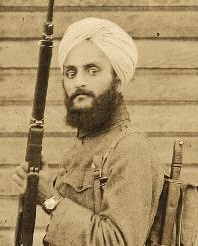
Bhagat Singh Thind, PhD, (3 October 1892 - 15 September 1967) was an Indian American Sikh writer and lecturer on "spiritual science" who was involved in an important legal battle over the rights of Indians to obtain U.S. citizenship.
Thind had fought for the U.S. in World War I. After the war he sought the right to become a naturalised citizen, following a legal ruling that "Caucasians" had access to such rights. At this time Indians were categorised as Caucasian by anthropologists.
In 1923, a crucial Supreme Court case United States v. Bhagat Singh Thind was decided in favor of the United States, retroactively denying all Indian Americans citizenship for not being Caucasian in "the common man's understanding of the term."
In the annals of Asians’ struggle for US citizenship, Bhagat Singh Thind’s fight for citizenship occupies a prominent historical place. .....More
Contents: Top 200. 210. 220. 230. 240. 250. 260. 270. 280. 290.
299
Anger or Krodh is rage, ire, wrath, irritation and annoyance. It is one of the five evils mentioned in Gurbani. It is an emotion and also a state of mind.
Anger is the feeling of antagonism, and irritation caused by some real or supposed grievance or inadequacy; it is a state of instability of the mind. It can be caused by both external and internal events.
You could be angry at a specific person (such as a co-worker or supervisor) or event (a traffic jam, a cancelled flight), or your anger could be caused by worrying or brooding about your personal problems or what someone has said or done, etc. Memories of traumatic or enraging events can also trigger angry feelings.
In the western cultures, it is believed to be a function of our primitive, animal-mode inherent self-preservation mechanisms - the confrontational aspect of what is commonly referred to as the 'fight-flight' response. Anger triggers a series of hormonal (endocrinal) changes intended to ready our body and senses for overt physical response to a potentially life-threatening situation.
"Violence, attachment, greed and anger," says Guru Nanak "are like four rivers of fire. Falling into them, one is burned, O Nanak! One is saved only by holding tight to good deeds" (GG, 147). .....More
Contents: Top 200. 210. 220. 230. 240. 250. 260. 270. 280. 290.
